 US Navy Fleet Destroyers (1942-80s): 58 Ships; DD-692 to DD-790
US Navy Fleet Destroyers (1942-80s): 58 Ships; DD-692 to DD-790The Sumner were about the last US destroyers of WW2 to see significant service. Their near-sisters, the Gearing class, were completed in the dying days or postwar. Above all, the Allen M. Sumner class destroyers marked a true break with the rather excellent and mass-produced Fletcher class, an inheritance of interwar designs, just “stretched” for better performances and additional AA. But the next classes went for three standard 5-in/38 twin turrets, while having extra space for AA. The hull was widened and the machinery repeated, making for an interim class. They arrived late, launched in 1944, commissioned from mid-1945, and for many, postwar. What they missed in WW2, they will make it for in the cold war, with radical modernizations into the 1970s, and further under other flags. #ww2 #allenmsumner #destroyer #unitedstatesnavy #pacificwar #framii
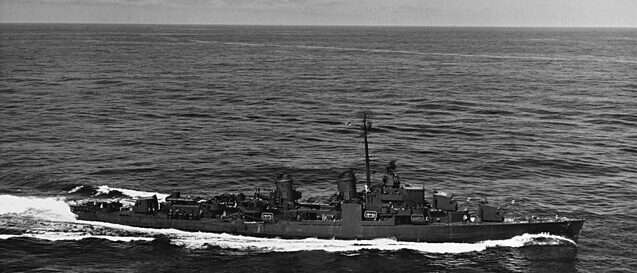
The Allen M. Sumner class essentials
In October 1941, the Bureau of Ships (BuShips) proposed a new destroyer design based on its new twin enclosed 5in/38, the same weapon already in production for heavier ships. One great advantage claimed over the Fletcher was reduced crowding along the centreline, which might make it easier to mount additional light AA weapons. At the same time the General Board began to work towards a new heavy destroyer of higher speed, which early in 1942 was proposed as a 2500-tonner; the Bureau of Ships proposal, employing a hull similar to that of the Fletcher and essentially the same machinery, was to be an ‘interim’ type. In fact more of these interim’ ships were ordered than of any other US destroyerdesign, although many were built to a modified design as Gearings.
Trials produced figures of 61,657shp = 32.99kts at 3086t (Moale). In a sense the Sumners were the victims of all that added centreline space, in that the Forces Afloat were able to demand more and more AA weapons (ultimately 2 quadruple and 2 twin 40mm and 11-20mm) which in turn contributed to a severe overweight problem; in the end the ships could not attain the speeds of their predecessors, and at the same time required more power to remain at cruising speed, so that their range proved inadequate. These problems were evident in the first units completed in 1943, and they were responsitble for the Gearing design. There was one other problem. The ships were designed with an Admiralty-style (partly closed) bridge, which proved very unpopular in service; early units had to be refitted, although a division of Sumners fought at Normandy with the original closed bridge. 6 DCTs and 2 racks were fitted.
In 1944 twelve ships (DD 735-740, 749-751 and 771-773) were completed as destroyer-minelayers, capable of carrying up to 120 mines each; they were not fitted with TT but had 4 DCTs and 8-20mm. As the US Navy had by then shifted to using aircraft for mining enemy waters, it is not clear whether any of these ships ever operated as a minelayer, although four were severely damaged AA picket duty off Okinawa.
Introduction by destroyersonline.com:
The Sumner class destroyer was the next evolutionary step from the Fletcher class and reflected the increasing need for Anti-Aircraft Warfare defense. They shared the same power plants as their predecessor but had twin rudders and were slightly longer and wider in the beam. They are often referred to as ‘short-hulls’ as the subsequent Gearing class DD’s were essentially the same as the Sumner class except for a 14 foot extension inserted into the middle of the hull. This was to give the ship a larger fuel capacity and, therefore, increased range.
Of the seventy Sumner’s Class DD’s built only five were lost to enemy action. The Meredith struck a mine during the D-Day landing and was lost to a German aircraft attack. The Cooper was sunk by a Japanese destroyer in the Philippines. The Mannert L. Abele was sunk by a hit from an “Oka”-bomb and a Kamikaze plane off Okinawa. The Drexler and the Hugh W. Hadley were both lost to hits by Kamikazes. Many others suffered severe damage from large numbers of Kamikaze attacks and various other battle actions but these were repaired and returned to service. Twelve of the seventy DD’s were converted for mine-laying duty while under construction.
As the years passed and the need for improved Anti-Submarine Warfare capabilites became evident, the Sumner Class DD’s received numerous modifications to the weapons and electronics on board. Improved surface and air search radars, ECM (Electronic Counter Measures) equipment, fixed and directable hedgehog launchers, new torpedoes and torpedo launching systems, DASH (Drone Anti Submarine Helicopter), fixed and variable depth sonar (VDS) systems were added extending the service life of the ships far beyond the expectations of the people that planned the first one. A few of these old work-horses are still around even today in the service of foreign navies… src
Design development of the Sumner class
The early start of the program went all the way back to 1939 when the Fletcher class was discussed at an early stage. Indeed in these early developments, several designs were proposed, some mixing already the twin 5-in/38 twin turret in development, and single ones. But ultimately a more conservative approach was chosen and the Fletchers ended with five single. The larger size and weight of these Mark Mk38 Mod0 mounts indeed, needed to review stability calculations: Not only because of the reinforcements of the weather deck, strenghtened supports below and extra hull framing, but also to widen the hull altogether.
Thus in 1942, the Admiralty started researching in effect a new 2,500 ton high speed destroyer, a project which required to cope with the extra dimensions, a machinery far superior to those of the Fletcher, which were not ready in time to meet the first specification. So the naval staff decided for a “interim” destroyer type with the previous machinery but the new intended hull and armament. This became in effect, the Sumner class. To simplify design time the same hull, widened by just 19 inches or 1.6 ft to 41 ft (12.5 m) instead of 39.5 ft (12 m). This wider hull of course had an immediate effect on speed loss, down to 36.5 knots instead of 38. For many in the top brass, still thinking of traditional surface engagements with IJN destroyers, this was an issue, only partially compensated by a greater firepower.
Another factor pleading for a wider hull was to get more space to stack AA guns, now the heavyer Bofors and Oerlikons. Indeed in 1942, reports from early engagements were clear about the lack of defensive armament onboard US destroyers: Both Crews and unit commanders unanimously wanted a drastic increase, but the weight increase caused by these additions had an effect again on stability and performances. The Fletchers were gradually improved, but at the sacrifice of one TT banks. The Sumners had this AA increase, while keeping in tact their two quintuple TT banks (for a time), but they were underperforming. Some commander saw this speed loss also as a hinderance to dodge air attacks as well. This problem was only solved in 1945 with the Gearing class. They were slightly less beamy at 40.9 ft (12.5 m) but compensated with more output, with the expected powerplant. But they arrived far too late to do anything in operations, although many by the summer of 1945 still thought the war will go on into 1946 as well.
Design of the class
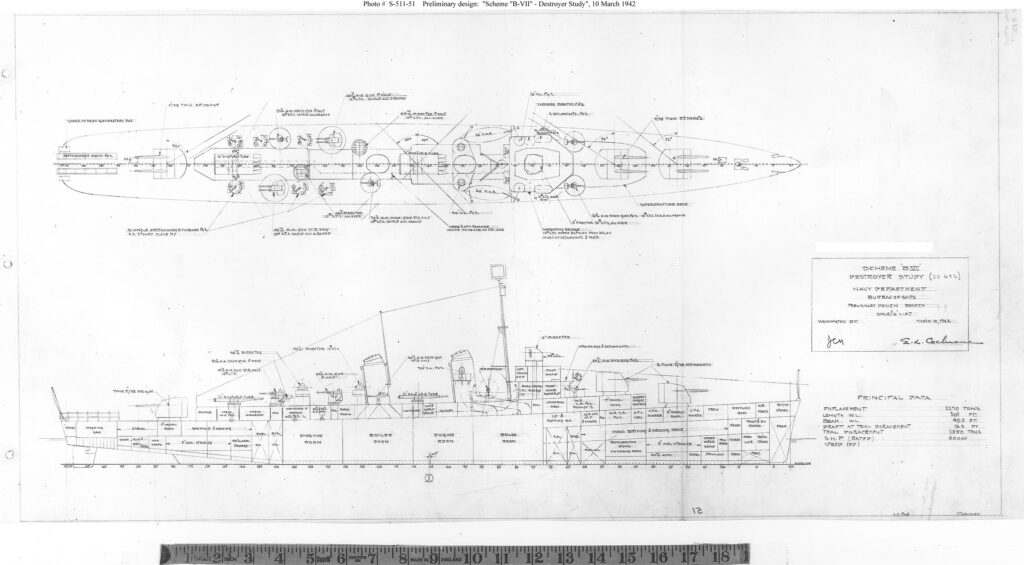
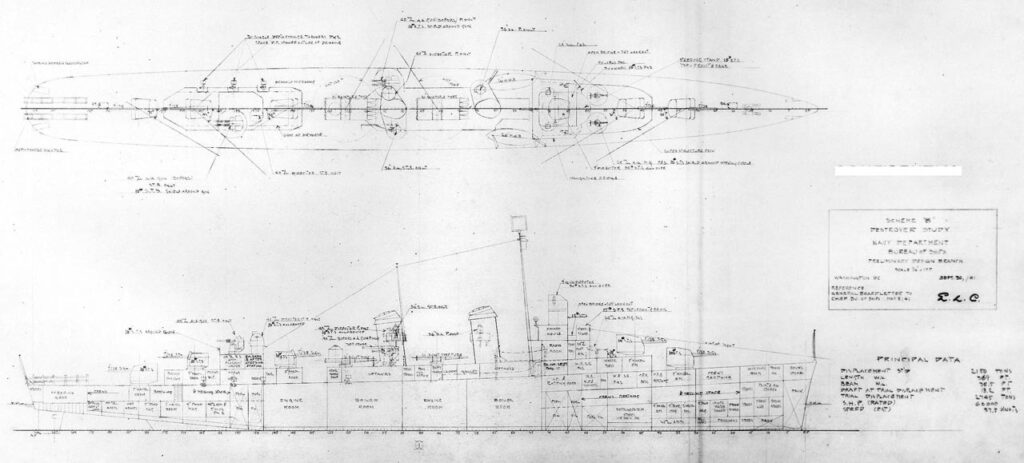
Scheme B, sept. 1941 src
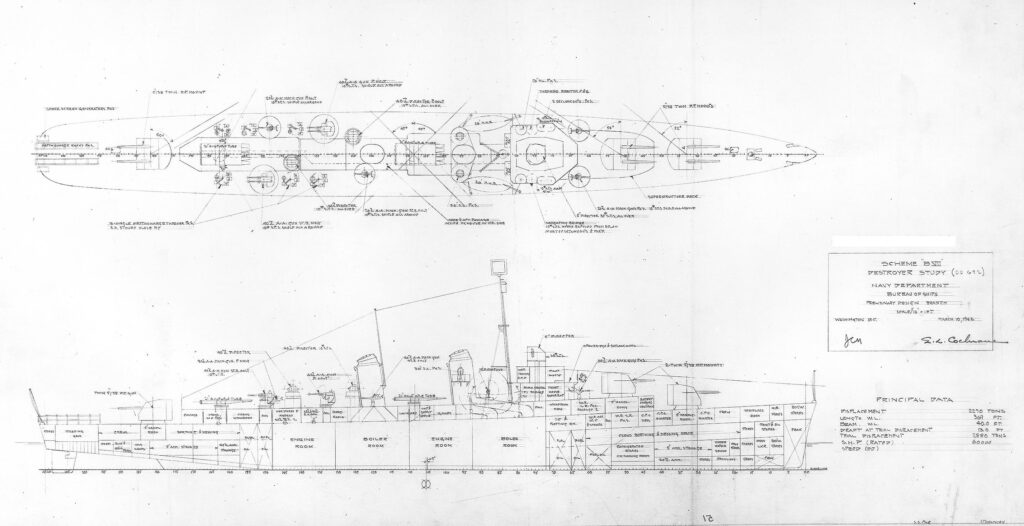
Scheme B VII, March 1942, closer to the final draft.
Hull and general design
The Sumner class had a profile reminiscent of the Fletcher class, since their hull was basically the exact same to gain design time, just widened by a small margin of 1.6 feet (50 cm). This was not seen in her silhouette, still elegant, but when seen from above. The prow was twice as high as the poop, and the general waterline shape was in “almond” with the greatest beam reached well past the amidship frames. In fact it was pas the aft funnel as well. The poop was still “semi-transom”, angular and rounded at the same time.
The first Sumner series (58 ships total), had an “admiralty” enclosed bridge, which discouraged first commanders asking for extra visibility. From those completed from early 1944, a new closed/open-bridge like on the late Fletcher class became standard. As for the general outlook, they had the same general silhouette, with two superfiring turret forward, albeit now twins, a low bridge behind, at first enclosed and prismatic, angular, enclosed with portholes to simplify construction. The view barely cleared the top of “B” turret. As traditionally, the main Mark 37 fire control director and its associated radar were placed on the roof. Commanders were not happy with the enclosed bridge and for ships in completion expected later in 1944, a new open/close bridge was created: The enclosed bridge like of the Fletchers had a forward surrounding open bridge with some voice piping included.

Gunnery control station general scheme by Buships, 1943
Past the bridge was the pole foremast, anchored at its back, supporting the early light radars, and the forefunnel, capped, and behind it al usualmly mounted on the superstructure, was the fore torpedo tube bank, same quintuple model as previous destroyer classes. Behind was the aft funnel, a bit lower and also slanted. Behind were located the bulk of the AA mounts, including two large quad Bofors creating wings, and four twins as well as single Oerlikons. Aft of these was the quarterdeck and radio house, aft torpedo tubes bank, and the aft twin turret on deck. Alongside the structure K-gun depth charge throwers were installed, and there was a single rack at the poop, where the last 20 mm mounts were located.
Internally, the ship had seven decks from the bridge to the “semi-deck” of the stern section. The hull had three internal full hight decks, dying when started the bulkheaded fore machninery room arrangement, in échelon to separare boilers and turbines. To alleviate any flooding, there was a strick compartimentation going up to the weather deck. To enter the machinery spaces, accesses from top only were practices and to join the poop from the prow, it was only possible by walking the weather deck all its lenght, albeit internally it was possible from “B” turret to “B” TT bank. Like the previous destroyers, the Sumners had a bulwark to protect the aft deck from waves and water spray, seated at the foot of the bridge. The novelty was that two wings blocks extended all the way to the beam aft of the bridge to support the forward twin Bofors mounts, further shielding the aft deck section. This gave these ships, as with the low bridges, a more bulkier, stockier, robust appearance compared to the dashing Fletchers. They were completely new animals.
Powerplant
As said above, there was nothing revolutionary about the Sumner class machinery. It was a repeat of the Fletcher class, wich just a few inches to spare either side: Two shafts, driven by two 2 sets of General Electric geared steam turbines, fed in turn by four Babcock & Wilcox boilers (that was the design standard, with changes between yards), all in separated rooms, single for the tubines, double for the boilers for redundancy. In case of a torpedo hut and flooding, they could survive. This powerplant gave a total of 60,000 shp, for a top speed of 36.5 knots. As for fuel, a total of 379 tons up to 504 tons when abolutely all void compartments were filled, were carried. This was a bit more than the max capacity of the Fletchers, at 492 tons, a difference only explained by the beamier hull as the tanks were unchanged in locations and general dimensions. This enabled an endurance of 3,300 nautical miles at 20 knots, whereas the Fletchers were reported at 6,500 nm but at 15 kts. Cutaway by Bob Barrett.
Armament
The game changer was not only the triple twin turrets, bringing an additional barrel, without sacrifice during the war (many Fletchers, most Bensons/Gleaves saw the removal of N°3 gun for more AA). In addition, they kept their two quintuple torpedo tubes banks, but without reloads, and most amazing of all, whereas some Fletchers started with a single quad 1.1 in “chicago piano”, rather mediocre, the Sumners started with two quad Bofors, two twins and many Oerlikons to round this up. It was just the start. During the was, their aftermost TT bank was often removed to make room for extra Bofors. Let’s dive into this:
DD692 to 709, 722 to 734, 741 to 748, 752 to 759, DD770, DD774 to 781, and DD 857 had the “stock” armament as first planned, the one described above. Mk 12 twnin mounts, two quad 40mm/56 Mk 1.2 located on the wings of the aft superstructure and two twin 40mm/56 Mk 1.2 located on platforms either side of the bridge; In addition eleven single 20mm/70 Mk 4 were peppered along the ship, on deck for most and some on the bridge. At the poop they formed a triangle. This was rounded by the usual ASW suite, six DCT (depth charge throwers) and two racks at the poop with a grand total of 56 depht charges in reserve, see below.
Main: Three twin 5-in/38 Mark 12 enclosed mounts
Placed for forward combat with two turrets superfiring forward (the N°2 caused stability concerns) and a single on the deck aft. They were the first time a twin turret was fitted on a US destroyers, since the Destroyer leaders of the Porter and Porter class which had a anti-ship mounts Mark 22 instead. The new Mark 12 was more compact but taller due to the high angle reload system enabling a great rate of fire. After the top edge fire control system which made these arguably the best dual purpose guns of WW2, using proximity fuses was another enormous advantage.
The turrets ended on any ship of the Navy from the destroyer to up level, light, AA, heavy cruisers, battleships and aircraft carriers. This was the great standard also used by the RN and for which untold quantities of rounds were turned by US factories. The stockpile in the billions was such that it could continue to feed arsenals using these ships, even modernized around the globe, until the very end of the cold war !
In Europe for example, all NATO navies used this caliber for decades, including for their own domestic destroyers, except Britain. Spain, Italy, France and West Germany, but also Greece Turkey, the Netherlands, etc.
Each turret had two Mark 12 guns, on a Mark 38 Mod 1 and Mod 2 (Sumner and Gearing respectively), weighting for the Mark 38 Mod 0, 95,700 lbs so the weight of a heavy tank.
However on destroyers if similar in design these mounts differed by having a much lighter construction but thinner shield. The also had simpler case deflection chutes in case of ejection chutes.
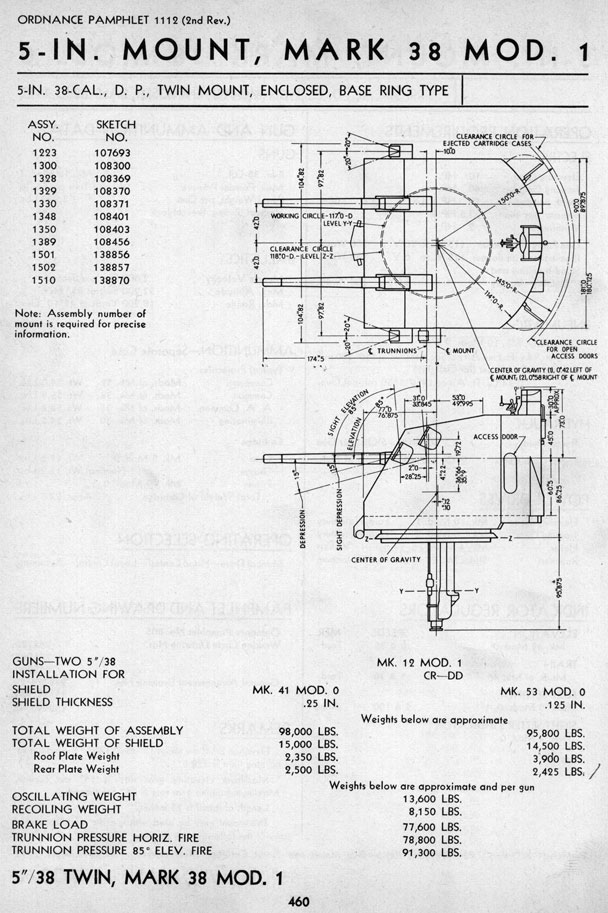
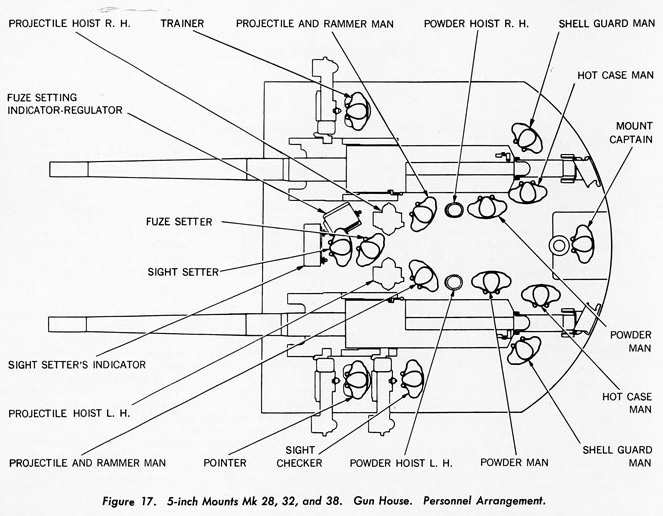
Above: General ONI file, Mark 38 mount. Not the clearance circle for the case ejection port hatches aft. Below: Top scheme showing the disposition of the crew inside a Mark 38 or similar twin mount (from navweaps).
⚙ specifications Mark 12 gun |
|
| Twin Mount Weight (Mk.38 mod0) | 95,700 lbs. (43,409 kg) |
| Shell | 20 × 110 mm RB. HE 123 g (4.3 oz), HE/T: 116 g (4.1 oz) |
| Muzzle velocity | 820 m/s (2,700 ft/s) |
| Rate of fire | Max 450, Practical 250-320, cyclic 900 rpm |
| Range | Effective 914 m (1,000 yd), max 45° 4,389 m (4,800 yd) |
| Elevation | -15/+85 degrees (30° train, 15° elevat./sec.) |
| Protection | Mod 0: 0.125 in (0.32 cm) |
| Crew | 9 |
Anti-Aircraft Armament
2″/50 Bofors (40 mm) Mark 12, Mark 2/4 quad, Mark 1 Twin
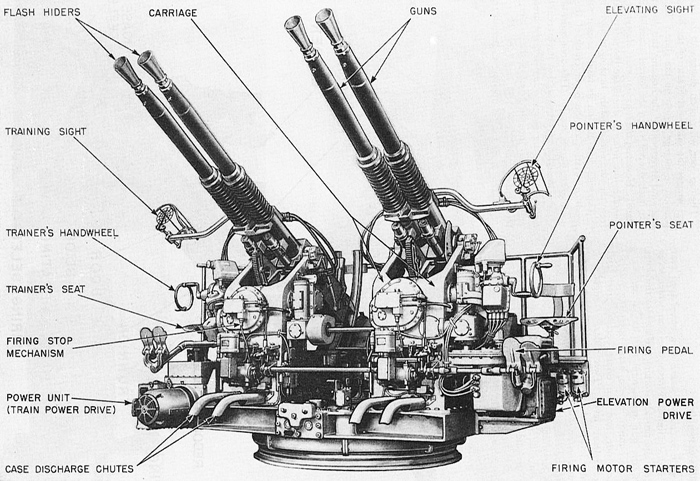
ONI 40 mm quad Bofors sheet
These models derived from the originals made by Swedish AB Bofors in the 1930s, and they were soon adopted by the US for mass production under its own patterns, with many improvements, deriving from earlier British models. Chrysler made 60,000 guns, 120,000 barrels at half the original projected cost. On the Sumner and Gearing class, as well as the modified Fletchers, they were available in both quad and twin mounts.
The former was the MK 12 quadruple mount, provided as standard with 2,000 rounds per barrel. Barrel life was c9,500 Rounds.
Mount: Mark 4 quad: Weight 22,795 – 24,553 lbs (10,340 – 11,137 kg), elevation -15/+90 (rate 55°/sec) train 50°/sec.
Crew: five men, gun commander, two gunners, two loaders. Recoil 7.9 in (20 cm)
RPM: 16-round bursts cycles, up to 120 rpm with a well-trained crew.
Round: 900 g (2.0 lb) HE 40×311R (rimmed) shell, 2,960 ft/s (900 m/s), penetration 4,000 yards (3,658 m): 0.60″ (15 mm)
Range: 7,200 m (23,600 ft), max practicable 3,800 m (12,500 ft), but max 22,800 feet (6,949 m) at 90°.
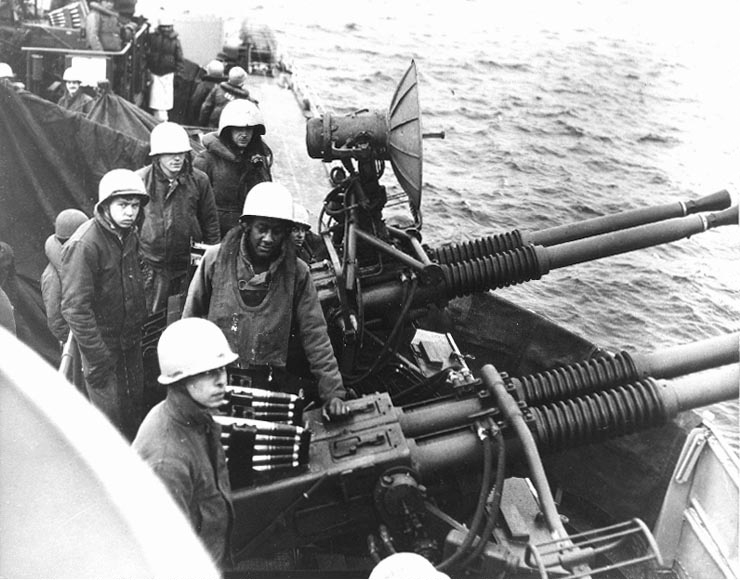
Both twin and quads mounts shared the water-cooled Mark 1 and Mark 2 Bofors guns. The quads were two twin mounts joined together, each pair had a left-hand gun Mark 1, right-hand gun Mark 2. The pairs were 60.0 in (1.524 m) apart. Elevation motors: 5 hp, training motors: 5/7.5 hp, Hydraulic drive gear. Fired using a delay gear to reduce inbalance and dispersion. In all, 2,300 quad mounts were provided to the Navy. More
1.1-in/70 Oerlikon (20 mm) single Mark

20 mm Oerlikon gun
Going back to Luftstreitkräfte planes gun project from 1918, took on in the interwar was Seebach Maschinenbau Aktien Gesellschaft of Zürich (SEMAG) into the 1935 into the FF, FFL and FFS family, licenced to Hispano-Suiza, Ikaria and others. The ship base Oerlikon SS (1938) was adopted and licenced, towards the 1SS of 1942, and 2SS from 1945 on the Gearing class. Coupled with the electric Mark 14 gunsight which triangulated an aiming point on a fast-flying aircraft using two gyro stabilization systems. These single mounts were shielded. Provision was four on the Benhams, Fletcher, bu it went to eleven for the Sumner and Gearing classes due their larger useful deck space and design modifications. This changed little as the war progressed due to the short time involved and because the Bofors was clearly preferred by the summer of 1945 with the “kamikaze onslaught” which decimated Fletcher class ships in particular in picket duty off Okinawa.
On the Sumner class, these eleven 1,695 lbs. (769 kg) mount Mark 4, 70 caliber (0.79″) were located xxxx
They had a Cyclic RPM of 450 rounds per minute, but practical 250-320 rounds, for a range of 3,840 feet (1,170 m) at 35° and up to 8,000 m max theoretical at 85° (-5/+87 degrees).
Elevation and traverse were manual, the gunner having shoulder pads encompassing his forearm to use the whole upper body. Legs were generally rarely moved except when following a low passing-by “bogey”.
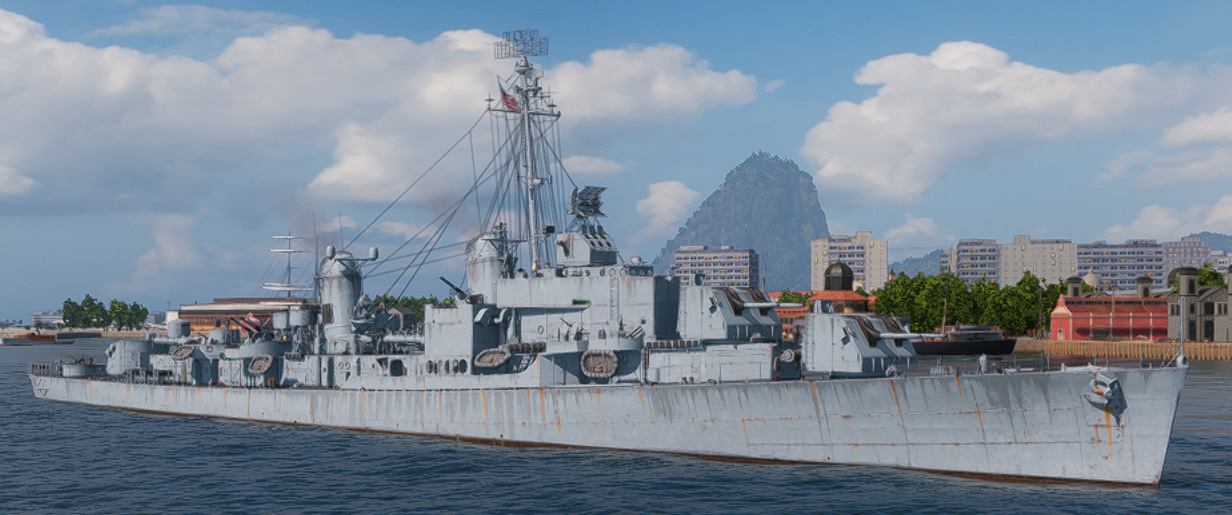
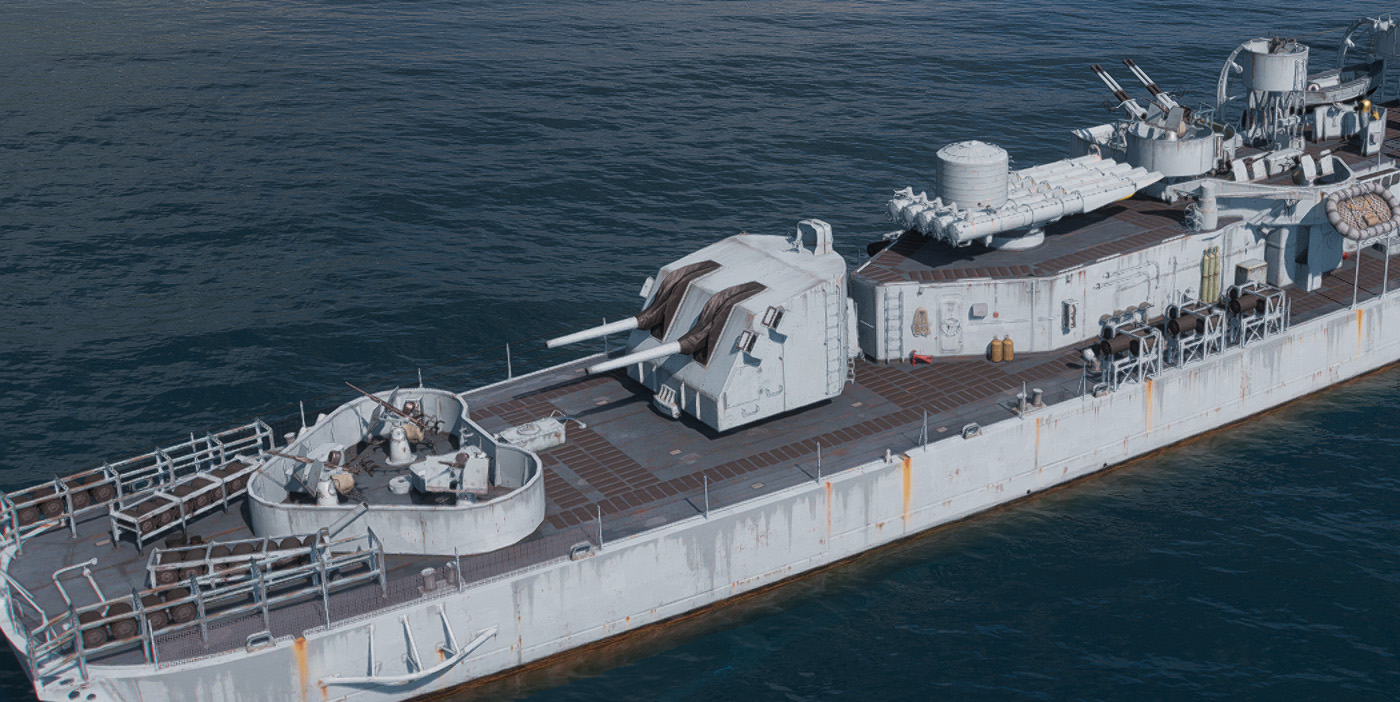
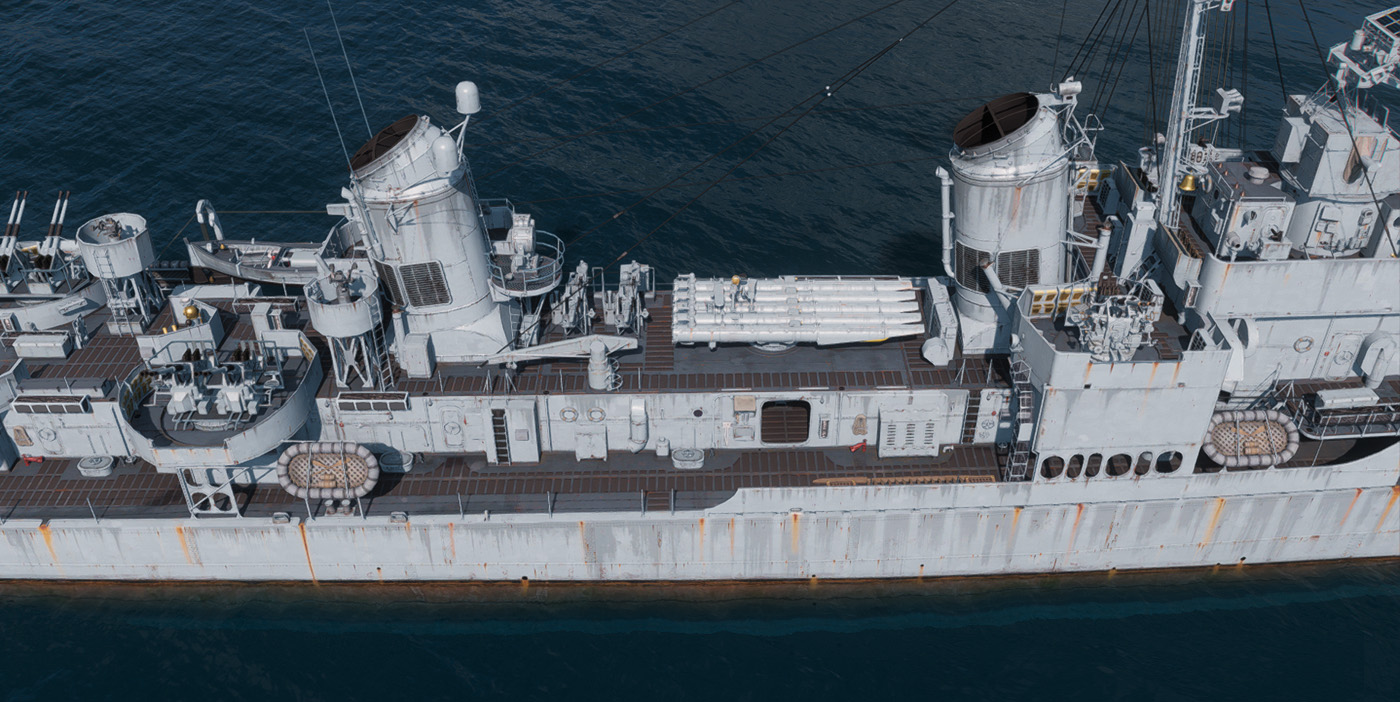
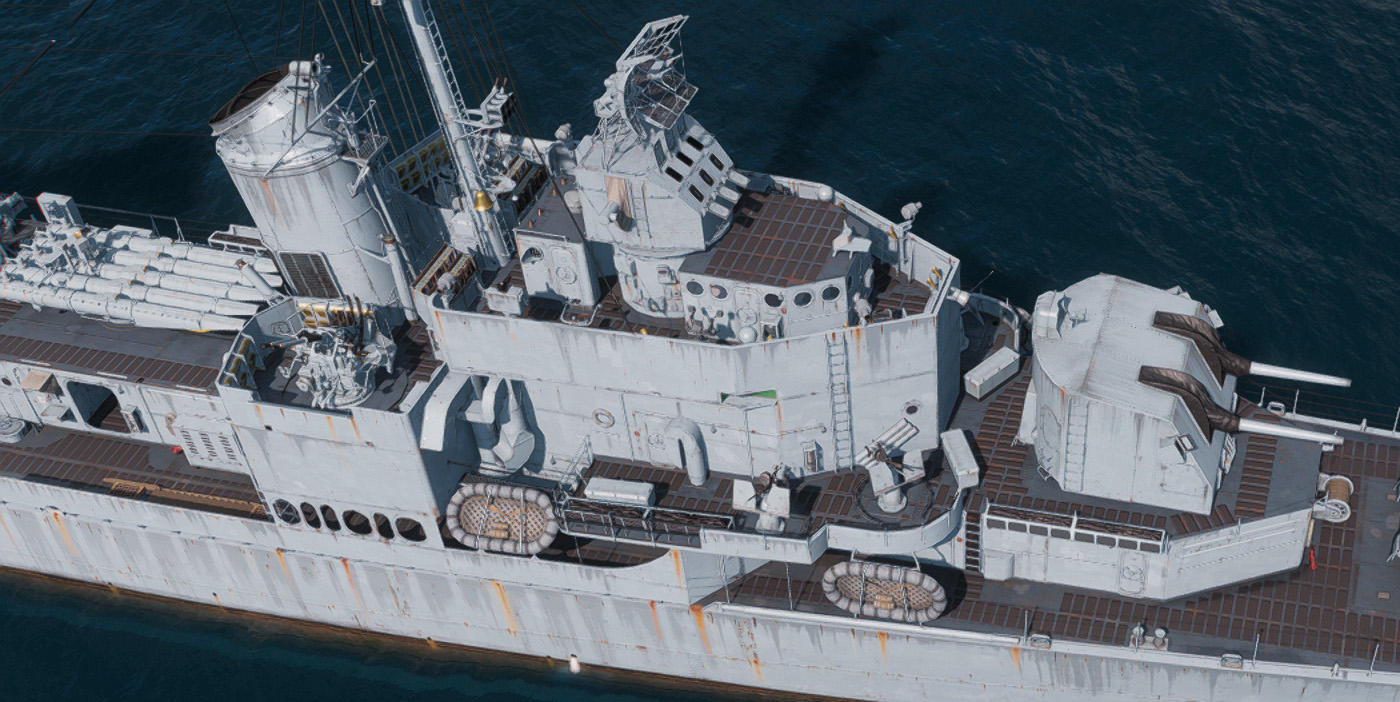
Details of the class (here, Gearing class).
ASW armament
Mark 8:
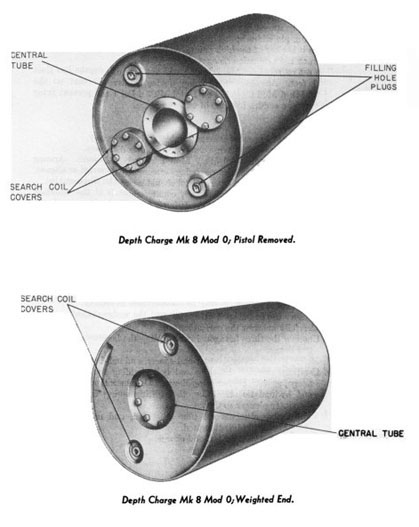
Introduced in 1943 these used a magnetic pistol, aluminum casing to avoid magnetic interference. A proximity model more accurate, 525 lbs. (238 kg) with a 270 lbs. (122 kg) TNT charge, sink rate 11.5 fps (3.5 mps) settings 50-500 feet (15-152 m). It was however found unreliable and maintenance-heavy wit a backup hydrostatic pistol fitted and probably retired in 1945 when the Sumners were commissioned.
Mark 9:
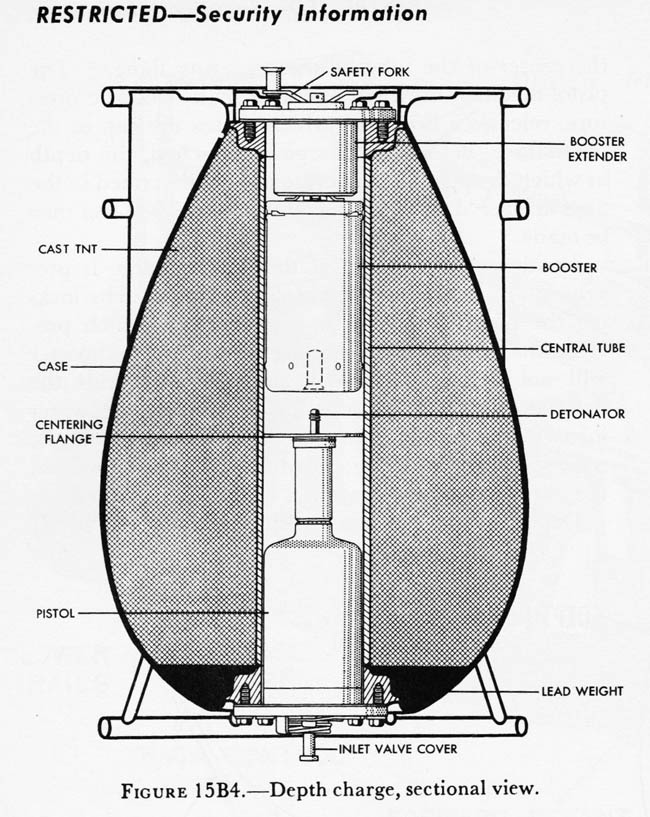
Standard-issue, reliable model from 1943 to 1945, evolution of the Mark 7 with “teardrop” shape for greater sink rate, and more accuracy. Mod 2: 1,000 feet (305 m), Torpex and spoiler plates to brake their rate of sink, but no on the Sumners which were fast enough to avoid the bast damage radius.
Mod 0, 1 and 2, weight 320 lbs./145 kg, or 320 lbs./145 kg and 340 lbs. (154 kg), 200 lbs. (91 kg) warhead, TNT or 190 lbs. (86 kg) Mod 2. torpex. Same Settings as for the Mark 7, 50-300 feet (15-91 m) or 600 feet (183 m).
About the K Guns (Mark 6)
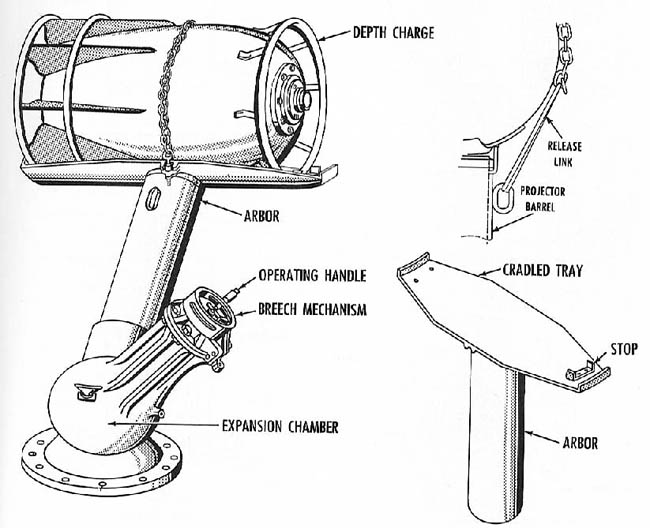
The USN standard Depth Charge Thrower (DCT), Mark 9 “K-gun” capable of 60 to 150 yards (55 to 137 m) in just 3.4 to 5.1 seconds. Placed in three systems aft on deck abaft the deckhouse.
The charges were 65 lbs. (29.5 kg) with increasing range, using black powder (settings 60, 90 and 150 yards (55, 82 and 137 m).
Sensors
Mk37 GFCS:
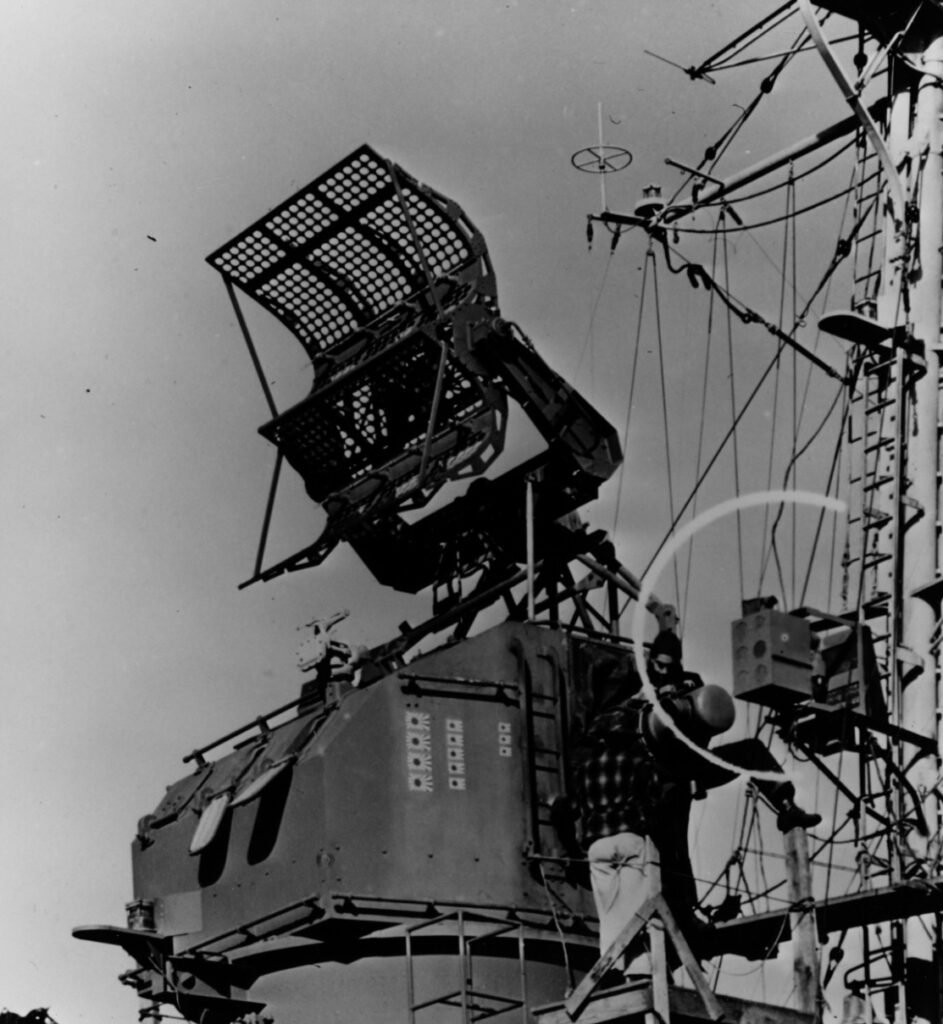
Soon after the Mark 33 director was created and first introduced, the Bureau of Ordnance started wotk on its successor, the Mark 37. At first just an improved director in 1936, trying to make it lighter, but it ended 8,000 pounds (3,600 kg), so heavier, but it had greater reliability, improved performance for the 5-inch guns especially in antiaircraft use. As for previous ships, the sensitive computer was installed below deck with a full CiC. It was of course installed over the bridge of the Sumner class, topped by a radar. At close-in ranges accuracy fell off however.
The computer was the elderly Ford Mark 1, which combined with the VT proximity fuze increased hit probabilities.
SC radar:
This 220 kW standard air surveillance radar (1942), Air but also Surface-search model worked on VHF band with a PRF of 60 Hz, a Beamwidth of 10–25°, Pulsewidth of 4–5 μs, Range of 48–120 km (30–75 mi) with a precision of 90–180 m (98–197 yd). It was installed on top of the pole mainmast.
Also the following:
-SG radar
-Mk 12.22 radar (combined with the Mark 37 director)
QGA sonar
Block diagram of the QGA system.
The QGA was a searchlight sonar system designed for installation on destroyers. The system has two complete sonar equipments that are practically identical. One operates on a frequency of 14 kc; the other, on a frequency of 30 kc. The 30-kc transducer can be tilted downward from an angle of 0° to an angle of 45° below the deck. This feature is of value when the sonar vessel is approaching a deep target. The QGA consoles are similar to the QGB console. They are installed side by side in the sonar control room. The two equipments of the QGA are capable of independent operation, or they may be slaved by a control on the 14-kc console. External tactical recorder can be used to control the transmission of either equipment or both of them.
The receiving system for each console consists of an audio receiver and a BDI receiver. The transmitters are conventional r-f amplifiers. A unicontrol-oscillator system tunes the receivers and transmitter of each unit.
The magnetostriction transducers are mounted on concentric shafts that are hoisted and lowered together. The 30-kc transducer is smaller because of its higher frequency. It is mounted over the 14-kc transducer. The training mechanisms are arranged so that the transducers can be trained independently of each other. src See also

Old author’s profile, more to come.
⚙ Sumner class specifications |
|
| Displacement | 2,610 t. standard -3 218 t. Full Load |
| Dimensions | 114.7 x 12.45 x 4.32 m draft (376 ft 6 in x 41 ft x 15 ft 9 in) |
| Propulsion | 2 shaft GE turbines, 4 Babcock & Wilcox boilers, 60,000 hp. |
| Speed | 38 knots (63 km/h; 39 mph) |
| Range | Oil 379-504t, 3,300 nm/20 kts |
| Armament | 3×2 5-in/38, 2×4, 2×2 40mm, 11x 20mm AA, 2×5 533 mm TTs, 4 DC, 2 DCT |
| Protection | 0.5 in machinery deck, bridge, 0.7 in belt |
| Sensor | Mark 37 gun director, SC radar, QGA sonar, later SG, Mark 12.22 |
| Crew | 336 |
General Assessement
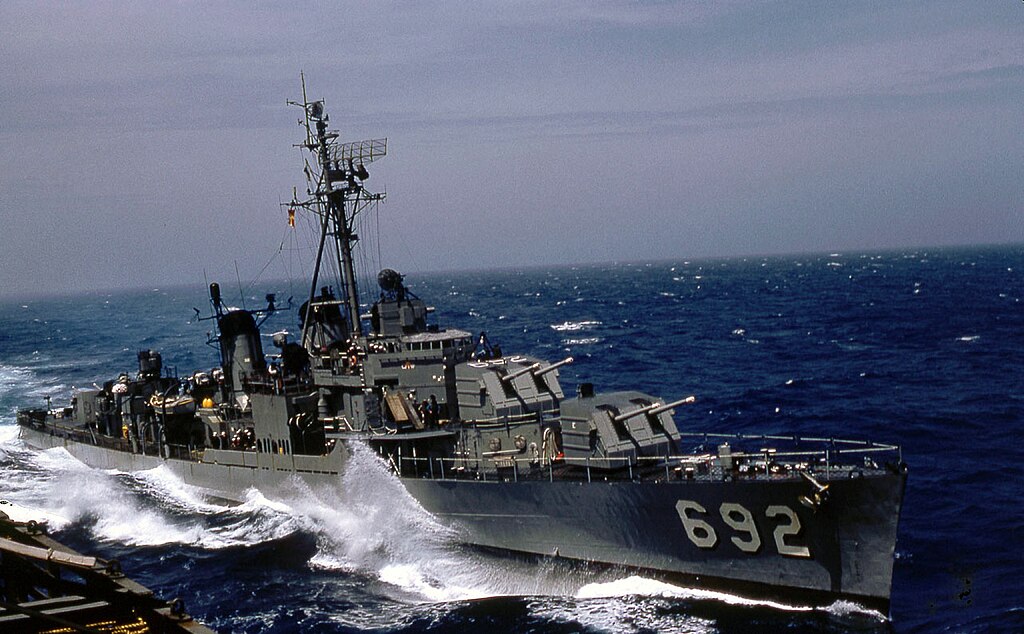
USS Allen M Sumner in 1959
The Sumner-class ships were overall satisfactory in service. They had the opportunity to distinguish themselves in late 1944 and 1944, although the last ones were not ready before the summer of 1945, seeing little action. 12 were completed as minelayers, but gave little satisfaction in this role and were converted back as radar pickets.
Four of them, present in Okinawa, were badly damaged by Kamikazes. Despite their commitments, only were lot in action: USS Cooper, Mannert E Abele, and Drexler.
Cold War Service:
More than the Fletcher class, which saw modernizations and widespread service post-war, both the Sumner and Gearing class underwent compehensive rebuilts as ASW destroyers, with ASROC and extensive weaponry. 33 went through the FRAM program and served in the US Navy well into 1970-1973. Most being transferred to foreign navies, replaced in the USN by the smaller, cheaper Knox-class frigates. 29 were sold to other navies: 12 to the Republic of China Navy, 2 to the ROKN, 2 to Iran, 1 to Turkey, 1 to Greece, 2 to Venezuela, 2 to Colombia, 2 to Chile, 5 to Brazil, 4 to Argentina. USS Laffey (DD-724) is preserved as museum ship at Patriots Point, Charleston, South Carolina.
Appearance (camouflages)
Drawings dated 29 February 1944.
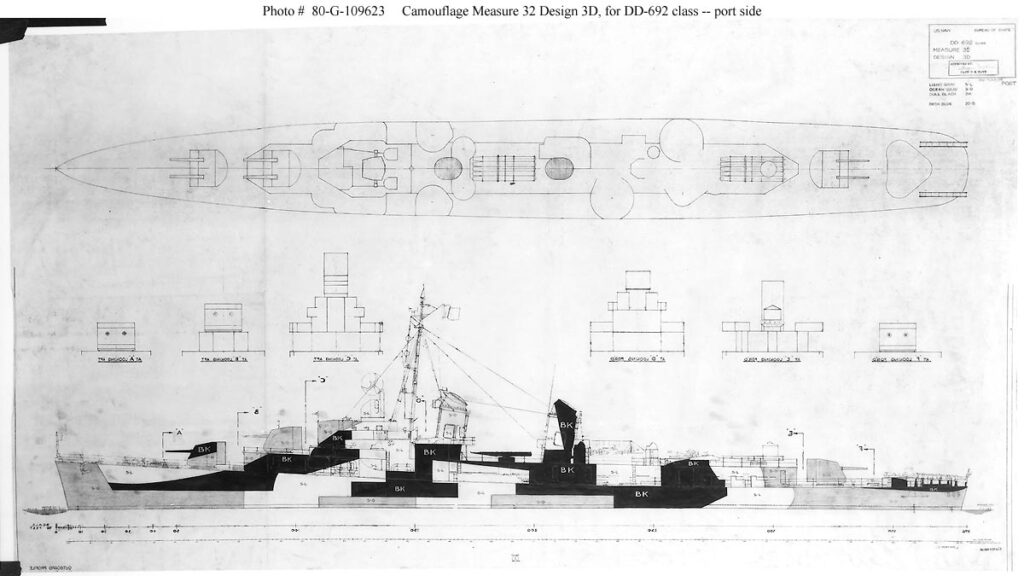
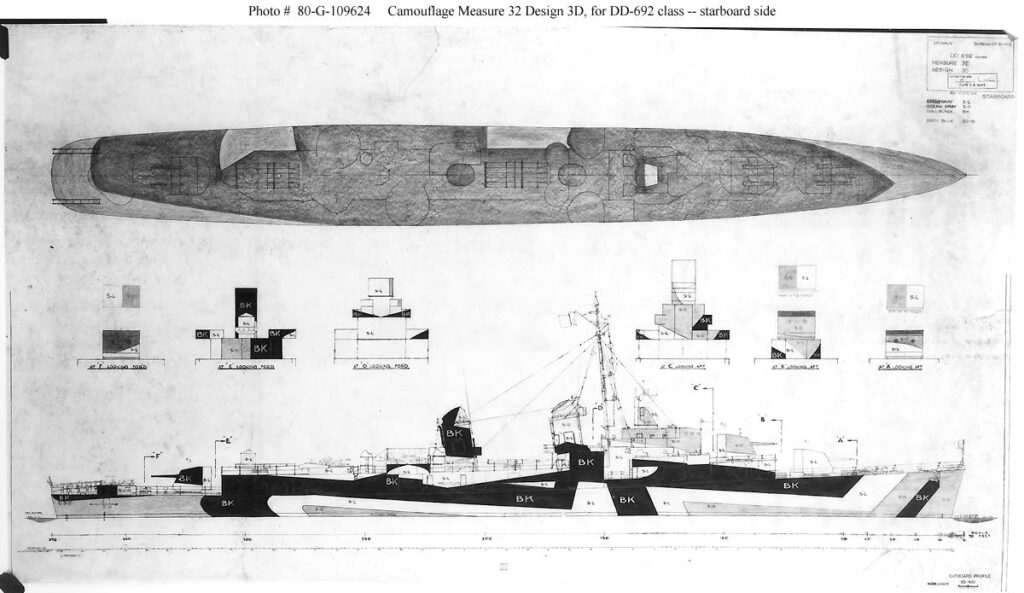
Measure 32 Design 3D, for DD-692 (Allen M. Sumner) class destroyers.
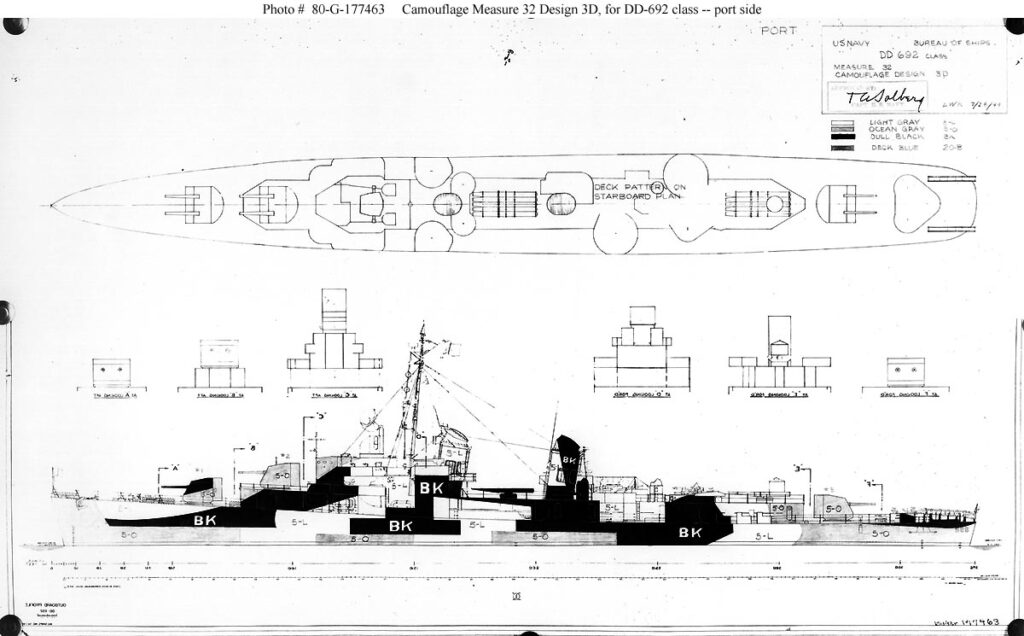
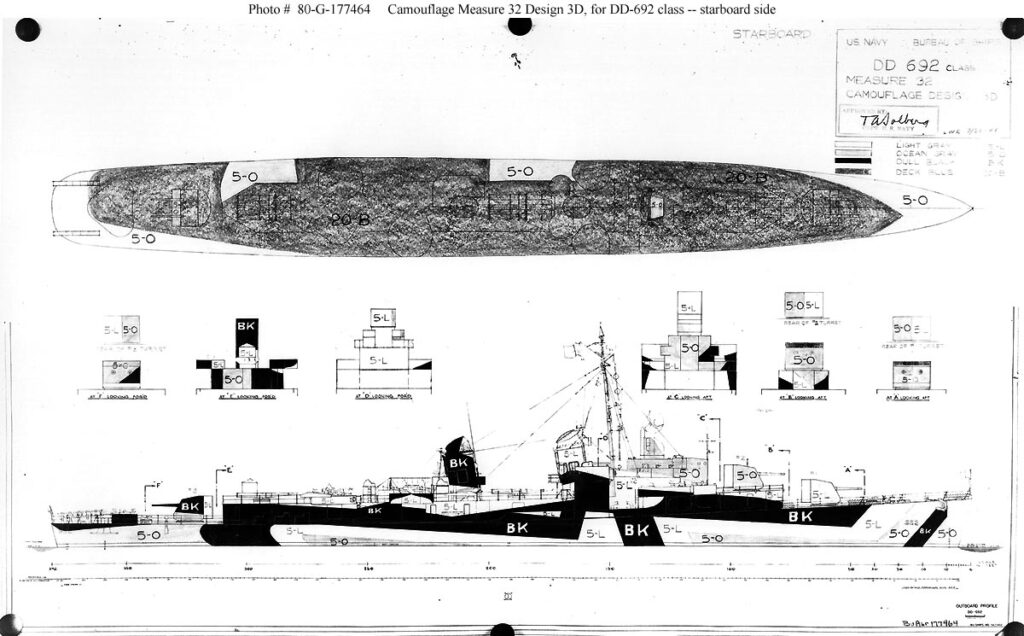
Measure 32 Design 3D, for DD-692 (Allen M. Sumner) class destroyers. Drawings dated 28 July 1944.
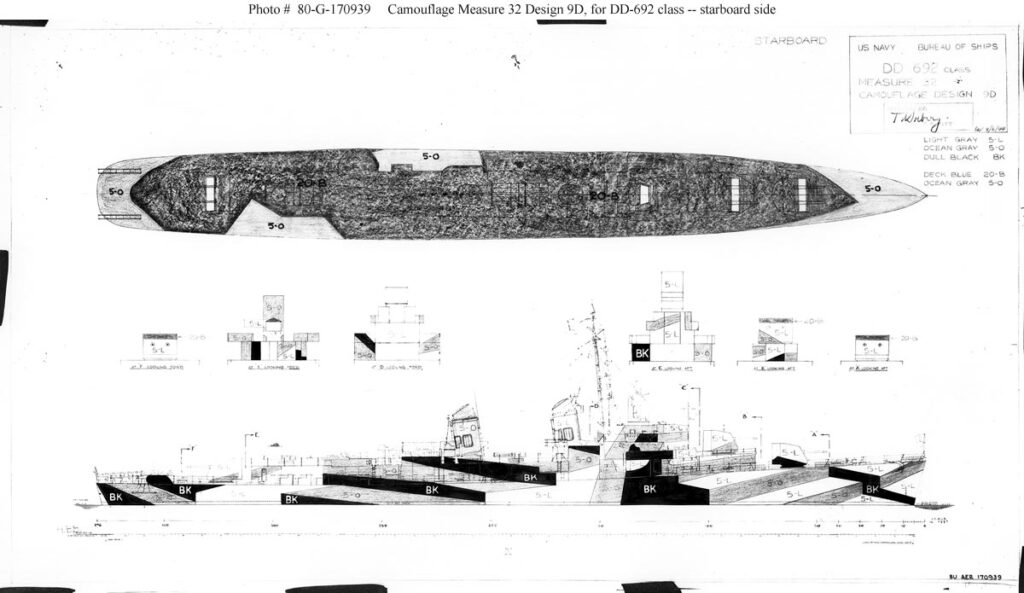
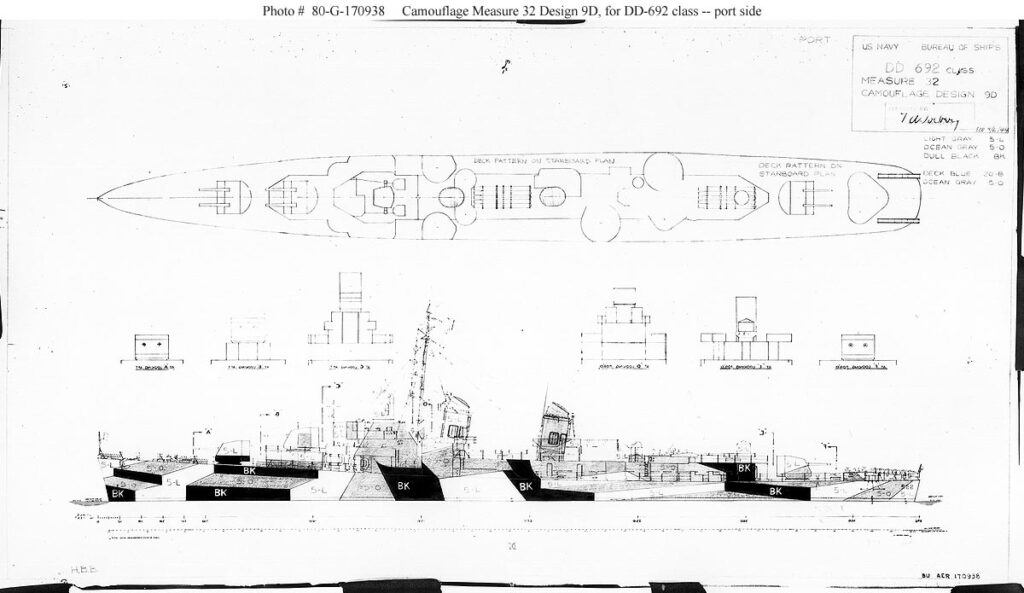
Measure 32 Design 9D, for DD-692 (Allen M. Sumner) class destroyers. Drawings dated 6 April 1944.
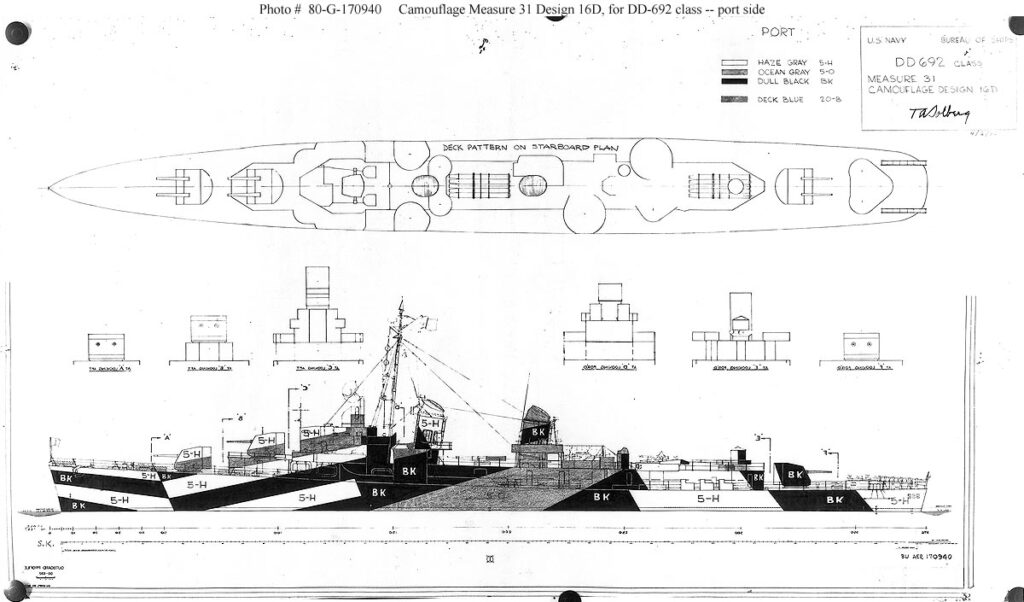

Measure 31 Design 16D, for DD-692 (Allen M. Sumner) class destroyers. Drawings dated 6 April 1944.
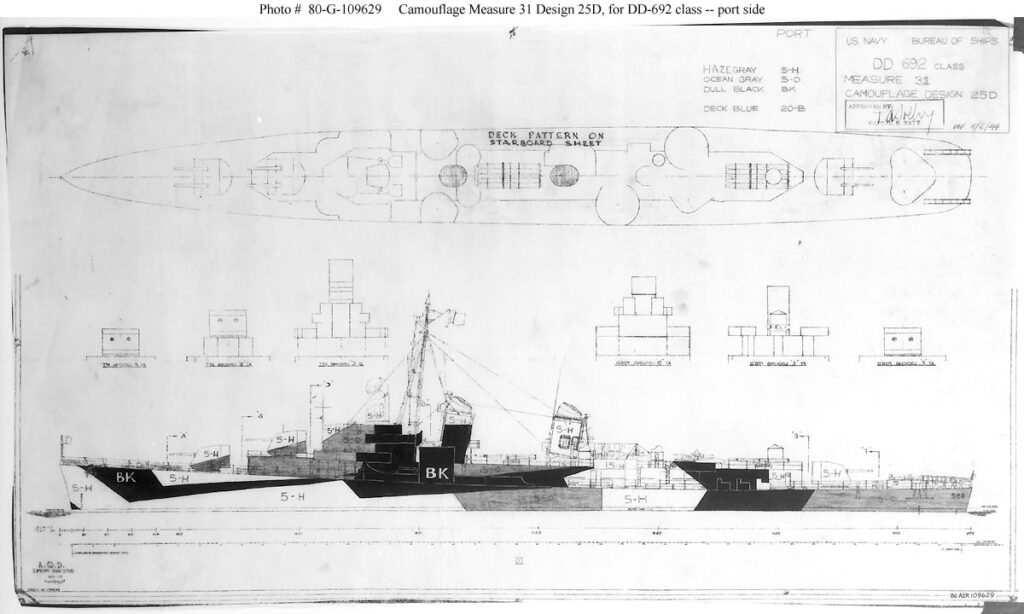
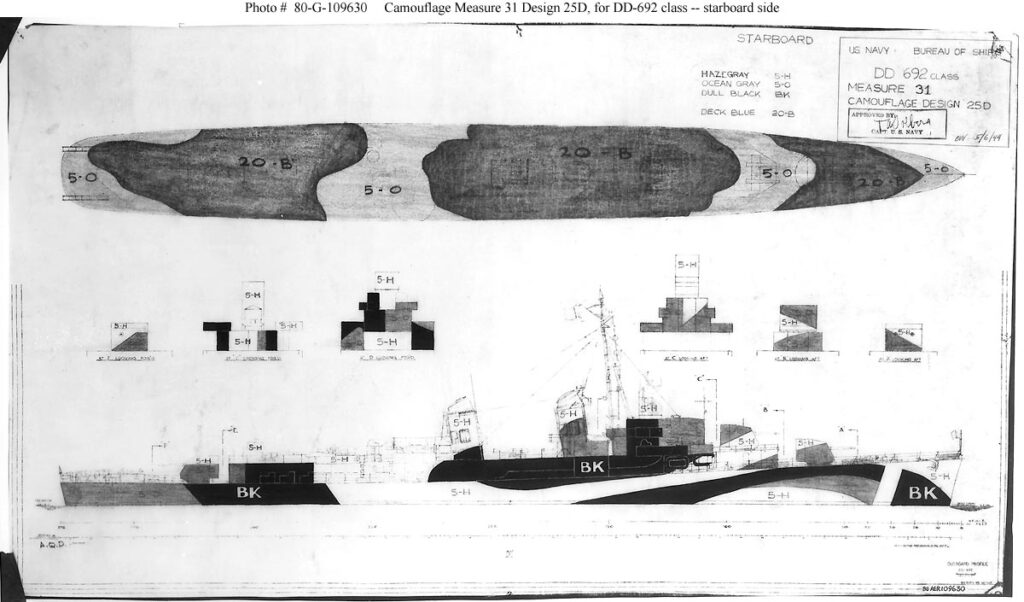
Measure 31 Design 25D, for DD-692 (Allen M. Sumner) class destroyers. Drawings dated 6 May 1944.
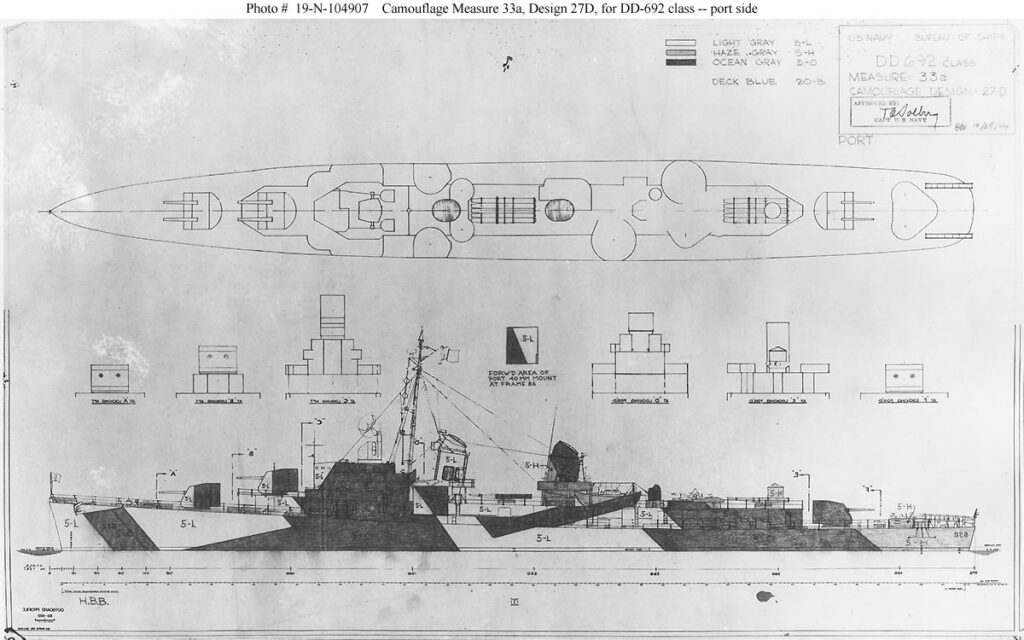
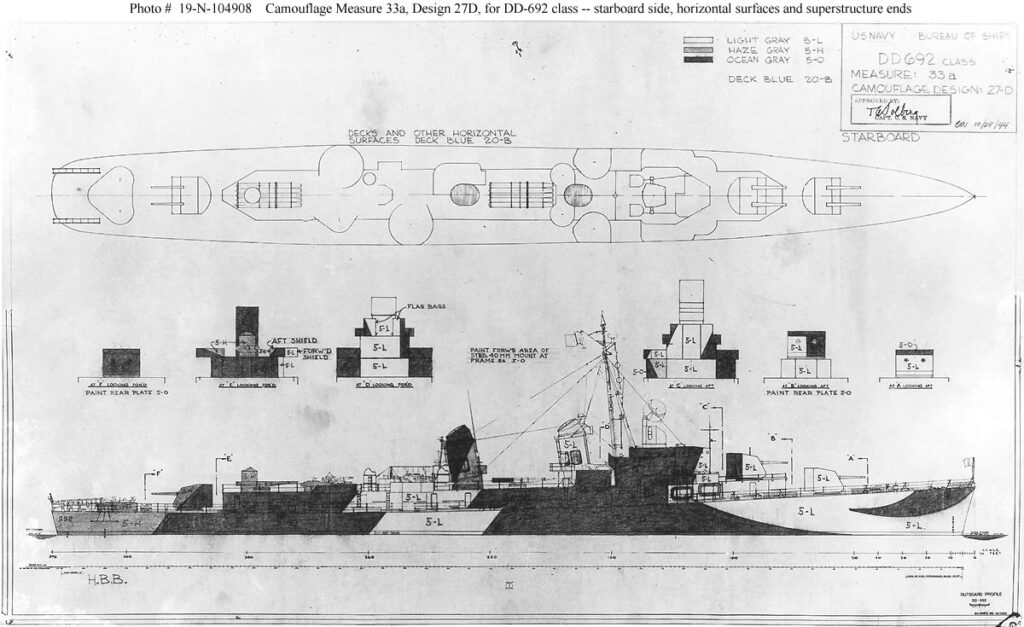
Measure 33a Design 27D, for DD-692 (Allen M. Sumner) class destroyers. Drawings dated 25 October 1944.
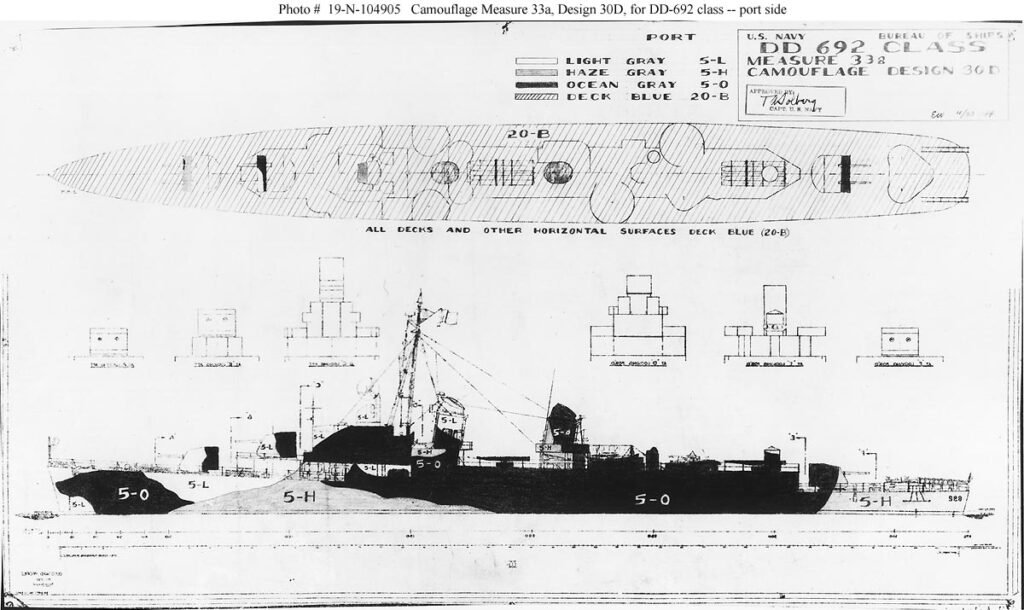
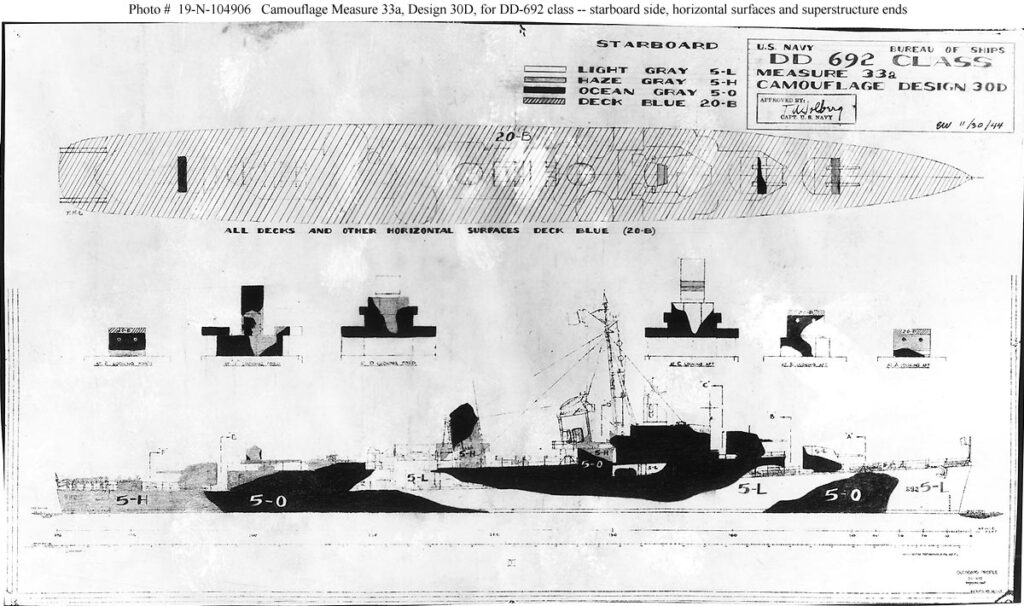
Measure 33a Design 30D, for DD-692 (Allen M. Sumner) class destroyers. Drawings dated 30 November 1944.
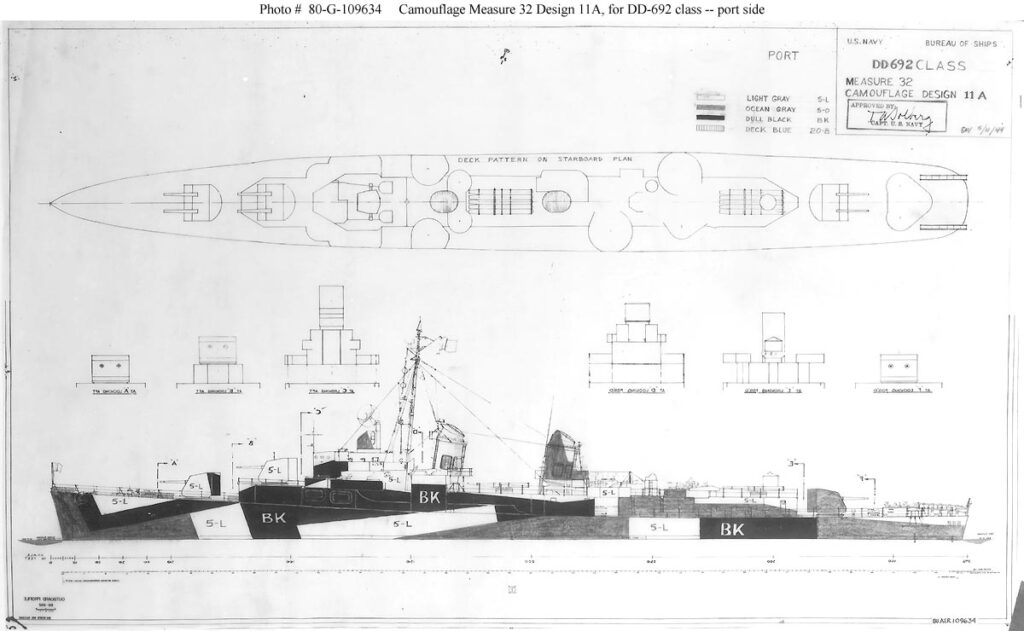
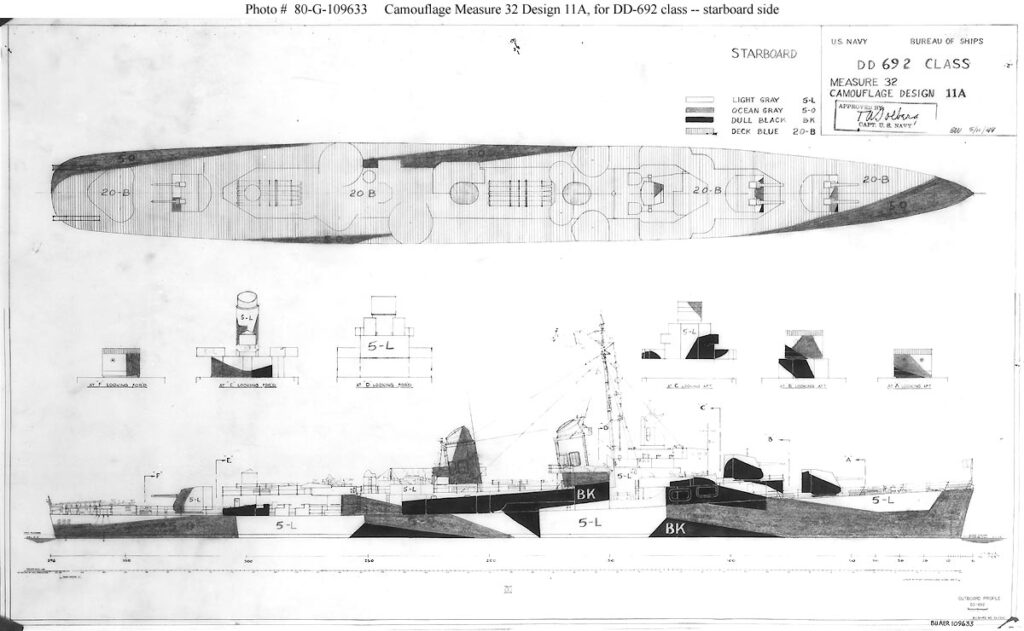
MS 32 design 11a, Drawings of May 1944

Allen M Sumner off New York in May 1944, Ms32 3D

USS Barton in December 1943, Ms.21

USS Allen M Sumner in 1945, Ms.22
Note: More to come, late bridge types.
Cold War Legacy and FRAM modernization

FRAM modernization cutaway scheme, BuShips April 1952
Since very few of the Sumner class were still in completion when the war ended in September 1945, all already saw a significant service in WW2, albeit short. Postwar, many were mothballed, waiting for a decision, as maintaining active ships was costly and the cold war was not yet there. In 1948 however, a substantial number were still in active service, being considered more successful than the Fletcher class, and replacing in any case all the prewar designs, including the wartime Bensons/Gleaves, last prewar design to see significant service also in Korea, and many ending under other flags, just were many of the Fletchers under MDAP.
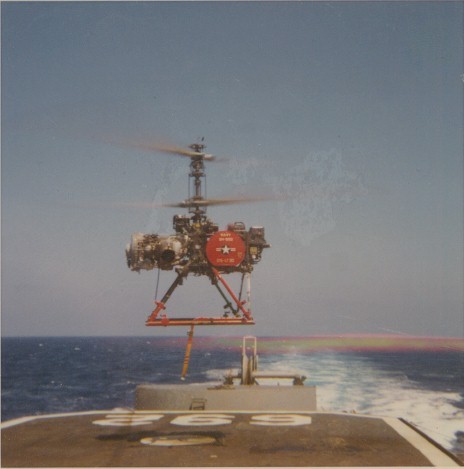
Both the Gearings and Sumners had now the status as main first line destroyers of the USN, replacing what remained of the WWI legacy “four pipers” still around, and all classes from the Farraguts to the Gleaves. With the war in Korea, more were extracted from the mothballed and feverishly prepared for a still possible degradation into WW III.
Thus, all ships in class spent the 1950s active, but also the 1960s as they underwent a signifivant cold war program called FRAM (Fleet Rehabilitation and Modernization). It went way more in depht compared to the Fletcher DDE conversions, and in all cases, was a full rebuilding, giving them another fifteen years at least of useful service. The mai driving force behind the program was the need to increase the numbers of hulls at sea to face the new potential war with USSR and the “russian subs scare”.
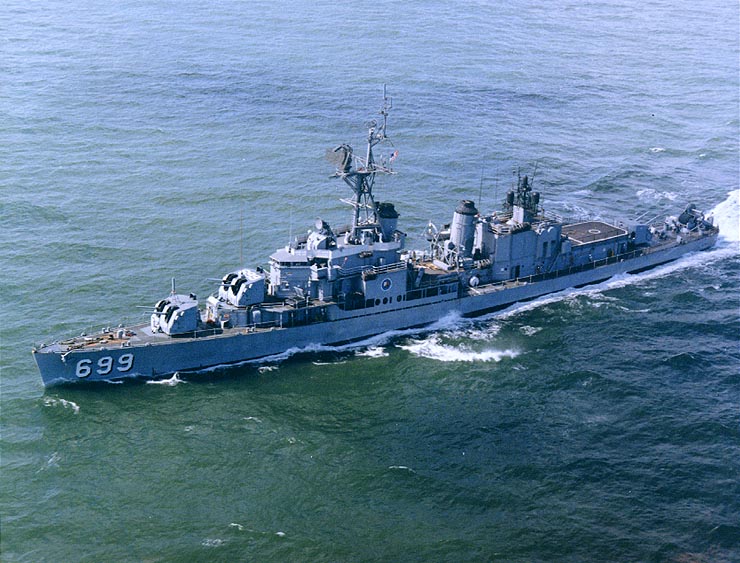
The Navy in the 1950s knew Soviet scientists and engineers recuperated a wealth of data and complete Type XXI and XXIII German new generation submarines, and were setting ambitious mass production plans. Admiral Arleigh Burke as a response to estimates that the Soviet Navy would have a force of about 300 modern fast-attack submarines pressed this progral by 1957. The Project 613 (NATO “Whiskey”) in particular was a headache which motivated a three prone response: Brand new classes of Frigates and Destroyers as well as modernizing WW2 destroyers and destroyer escorts to face the challenge.
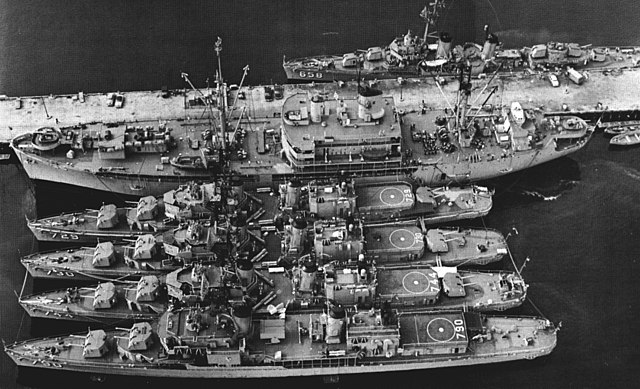
USS Bryce Canyon as AD-36 with other such converted Sumners at Terminal Island in 1962.
Concerning the program applied to the Sumner and Gearing, it was relatively similar in scope but different in nature and finality: The ships were to be transformed into dedicated, pure submarine hunters in place of their former WW2 multirole tasking. The Suùners received the FRAM II modernization in majority, albeit some Gearings and even Fletchers als received this upgrade. The rear deck was converted as a flight deck for the DASH (an early drone which proved unreliable in service), with the aft turret removed, new 12.75-inch triple torpedo tubes placed amidships, but ASROC not installed. Some retained all three 5-inch/38 twin mounts and received two new 21-inch torpedo tube s(Mark 37 ASW homing torpedo) as well as variable depth sonar (VDS). Initially this was for just five more years of service.
A total of 95 Gearings and 33 Allen M. Sumners received FRAM upgrades from 1960 to 1965, seeing servive in Vietnam but the ASROC-less Allen M. Sumners were decommissioned sooner in 1970–1973 or transferred as is to foreign navies (see later). The Gearings survived a bit longer, but were replaced gradually by the new Knox-class frigates as the new Spruance-class destroyers, far more capable.
Note: A dedicated article will be made on Sumner FRAM detailing their cold war career in the future.
Under other flags (1970-90s)
Albeit considered obsolete even after their “austere” modernization, the 33 Sumners still around were placed on the international market, 29 sold with some help from the MDAP program that was still running at the time, to allies and friendly nations. These were per fleet the following: 12 to the Republic of China Navy, 2 to the Republic of Korea Navy, 2 to Iran, 1 to Turkey and another to Greece. Close to home, 2 to Venezuela, 2 to Colombia, 2 to Chile, 5 to Brazil, 4 to Argentina. They served well into the late 1980s for many.

 Argentina
Argentina
Segui, Hipólito Bouchard, Piedra Buena, +USS Mansfield DD-728 for spare parts.

 Greece
Greece
To Greece: USS Ingraham (DD-694), as Mialouis ()

 ROCN
ROCN
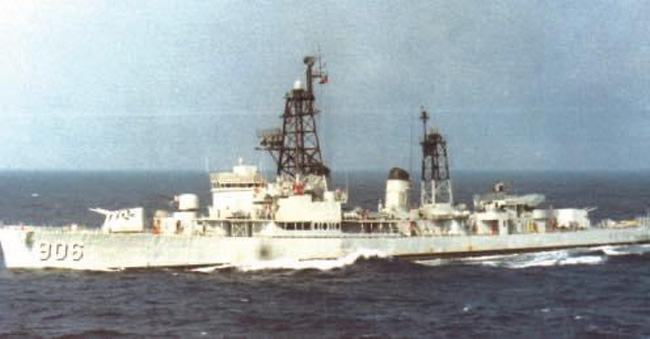
Huei Yang, Yuen Yang, Dae Gu, Po Yang, Hsiang Yang, Lo Yang, Heng Yang, Nan Yang in 1969-74 +USS Lyman K. Swenson DD-729, USS John A. Bole DD-755, USS Lofberg DD-759 for spare parts.

 ROKN
ROKN
USS De Haven (DD-727) to Republic of Korea Navy in 1973 as Incheon,

 Chile
Chile
Ministro Zenteno

 Columbia
Columbia
Santander (DD-03), Caldas (DD-02)

 Brazil
Brazil
Mato Grosso, Rio Grande do Norte, Alagoas, Espirito Santo.

 Turkey
Turkey
USS Hugh Purvis DD-709 July 1972 as Zafer (F 253).

 Venezuela
Venezuela
USS Beatty DD-756, sold to Venezuela 14 July 1972 as Carabobo
Read More
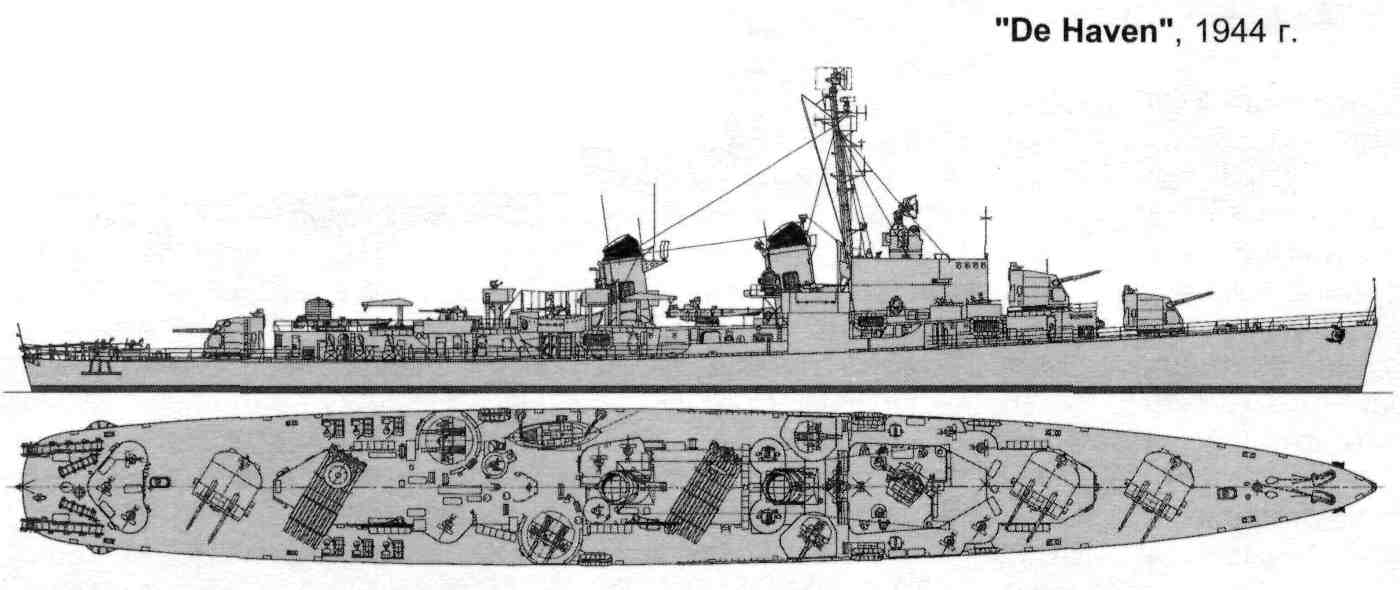
Two view of Sumner in 1945
Books
Friedman, Norman (2004). US Destroyers: An Illustrated Design History
Conway’s all the world’s fighting ships 1922-47
Links
on navypedia.org
on en.wikipedia.org
on dd-692.com/
camo on ibiblio.org/
on history.navy.mil/
nice colourized photo by Alex Colors Studio
web.archive.org/ destroyersonline.com/usndd/sumnrasbuilt.htm
navsource.org/ FRAM
CC photos
microworks.net/
Model Kits
General query on scalemates
The subject has been well covered on 1:700 but let’s cite Blue Ridge Models 1:350. Mostly old kits however. And only the WW2 appearance, not FRAM II.
Sumner class destroyers in service.
All were commissioned well before V-Day, in January-April 1945 for the last ones. So more articles will be added over the next months but not the whole class since the whole article is alreay massive to load. There will be a selection past the first ten ships of the class. Note also only their WW2 is seen here. Their coldwar career will be seen in a future Sumner FRAM article and their career under other flags (29 out of 33) in respective nation’s pages.
USS Allen M. Sumner, Moale, Ingraham, Cooper, English, Charles S. Sperry, Ault, Waldron, Haynsworth, John W. Weeks, Hank, Wallace L. Lind, Borie, Compton, Gainard, Soley, Harlan R. Dickson, Hugh Purvis, Barton, Walke, Laffey, O’Brien, Meredith, De Haven, Mansfield, Lyman K. Swenson, Collett, Maddox, Hyman, Mannert L. Abele, Purdy, Robert H. Smith, Thomas E. Fraser, Shannon, Harry F. Bauer, Adams, Tolman, Drexler, Blue, Brush, Taussig, Samuel N. Moore, Harry E. Hubbard, Henry A. Wiley, Shea, J. William Ditter, Alfred A. Cunningham, John R. Pierce, Frank E. Evans, John A. Bole, Beatty, Putnam, Strong, Lofberg, John W. Thomason, Buck, Henley, Lowry, Lindsey, Gwin, Aaron Ward, Hugh W. Hadley, Willard Keith, James C. Owens, Zellars, Massey, Douglas H. Fox, Stormes, Robert K. Huntington, Bristol
 USS Allen M. Sumner (DD 692)
USS Allen M. Sumner (DD 692)

Sumner in her shakedodwn cruise 26 March 1944, just commissioned.
USS Allen M. Sumner was laid down on 7 July 1943 at Kearny, New Jersey (Federal Shipbuilding and Drydock Company) as lead ship of the class, launched on 15 December 1943 and sponsored by Mrs. Allen M. Sumner, Captain Sumner’s widow. She was commissioned at New York Navy Yard where outfitting took place, on 26 January 1944. Captain Allen Melancthon Sumner, a United States Marine Corps captain, was killed in action during World War I. He was one of the many WWI USMC killed in action on the western front, and in that case, trained at Verdun and took Command of 81st Company, took part in the action at Belleau Wood and became battalion commander of the right front. On July 19 he was killed at Vierzy, near Soissons, before the attack on Tigny by a HE shell. He received the French Croix de Guerre with Gilt Star and 3 Silver Star Citations, buried in the American Cemetery at Belleau.
She departed New York Navy Yard from 3 March for shakedown off Bermuda, Carribean, and back to New York for post-fixes on 8 April until 3 May. Then she left for Norfolk, and started advanced training and notably started to train nucleus crews for future Sumner class DDs. She was back in New York and had a five-week availability, then she departed on 12 August this time for the Pacific, conducting AAW/ASW training via Panama on 29 August, San Diego and proceeded to Hawaii, Pearl Harbor on 14 September, starting fleet training in the Hawaiian area.
Allen M. Sumner in the Atlantic, 26 March 1944
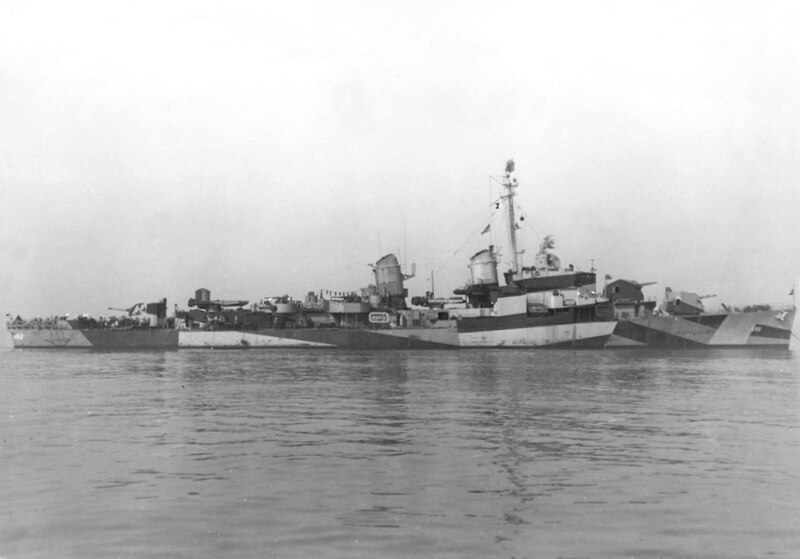
Sumner off NyC in May 1944
She departed on 23 October escorting USS North Carolina for the western Pacific via Eniwetok, Ulithi lagoon on 5 November, then underway on the 19th to join TG 38.4 at sea, part of TF 38, the fast carrier fleet. She proceeded to Yap Island for strikes on 22 November and back to Ulithi. Next she took part in the Philippines Campaign. San Pedro Bay on 29 November, Leyte Gulf and Ormoc Bay with sisters USS Moale and Cooper.
The Battle of Ormoc Bay

IJN Kuwa and Take were part of the Matsu-class escort destroyers. Much smaller than the Sumners (1,282 t) they still had twin and single 127 mm (5 in) DP guns and five 610 mm (24 in) torpedo tubes.
After 23:00 they were targeted by Mitsubishi Ki-46 “Dinah”, one near-missing Allen M. Sumner 30 yards (27 m) at her starboard bow, but the bomb blast pierced her hull with fragments (12 wounded) but the fire was contained.
After midnight, radar contact on Japanese destroyers (IJN Kuwa and Take) left to her first of very rare surface engagements as they rushed forward, and after 10 minutes IJN Kuwa sunk. Take scored hits as she was engaged by USS Moale, a Type 96 “long lance” torpedo hitting USS Cooper amidships breaking her in two with half her crew. Most were later rescued by PBY Catalinas since the destroyers were caught by heavy shore battery fire, with the threat of more planes around. On the 3rd, they left Ormoc Bay for San Pedro Bay.
Action on Mindoro
Allen M. Sumner then spent next nine days in San Pedro Bay in repairs and fended off one air raid, with one down at long range (9,000 yards/8,200 m) during final approach on 6 December. On the 12th she joined back TG 78.3 sailing to Mindoro under Rear Admiral Arthur D. Struble, repelling another air attack underway. On the 15th she took part in the preinvasion shore bombardment, and the subsequent landings went forward against negligible opposition. With USS Moale and Ingraham she splashing an enemy light bomber part of several attacks. She was back to Leyte on the 18th and on 26 to 29 December, escorted a resupply echelon to Mindoro and back.
Invasion of Luzon
On 2 January 1945 she left San Pedro Bay to take part of the invasion of Luzon in Lingayen Gulf, screen cruisers and battleships of Vice Admiral Jesse B. Oldendorf’s TG 77.2 committed to the pre-invasion bombardments. On 6 January she sailed into Lingayen Gulf to cover minesweepers but at noon, they were hit by kamikazes. The first plane was repelled by the massive AA barrage the second was a decoy for a third run on Allen M. Sumner. Blasted in flight, it crashed on her port bow close to her aft stack/torpedo mount. The impact killed 14, wounded 19. She had to retire back to the cover of TG 77.2 but still remained in action all along the Lingayen operation, until 14 January.
Repairs, Tokyo Bay and end of the war
She had to return to the United States for repairs as the logistic fleet’s floating docks at San Pedro were already full. She transited via Manus, Admiralties, on 18 January for fixes for nine days, departing again on 27 January escorting the escort carrier USS Kadashan Bay via Majuro, Pearl Harbor on 6 February and Hunters Point in California on 13 February, under repairs were complete on 10 April 1945. She resumed training future sumner class crews along the west coast until 17 July, relieved and sailed from San Francisco back to the western Pacific via Oahu for three weeks of training.
On 12 August she was prepared to sail back to the action and learned abour the capitulation two days into her trip. She went on to Eniwetok, and joined TG 38.3 in Japanese waters. She stayed for three weeks of postwar patrols with TG 38.3 and TG 38.1, entered Tokyo Bay on 16 September, stayed six days and departed for the Marianas, Saipan and back to the United State’s west coast in October 1945, resuming training for more destroyer crews, this time of Gearing class destroyers in completion. The war was over for her, and this earned 2 battle stars. She will win three more in Korea and Vietnam later.
A quick look at Allen M. Sumner long postwar career

USS Allen M Sumner in 1959
By May 1946 she returned to the Central Pacific for Operation Crossroads, at Bikini Atoll and Marshall Islands. After a run back to the USA she made a cruise in the Far East which (Australia, Marianas, Philippines, China, Japan). In 1949 she was assigned to the Atlantic Fleet, HP Norfolk, with a TOD in Mediterranean, 6th Fleet until March 1951, and returned to the Pacific to take part in the Korean War via the Mediterranean, Suez Canal, Indian Ocean to Yokosuka and TF 77 in the Sea of Japan, then TF 95. Later she alternated east coast and West Indies/European waters tours. She was present for the Suez crisis, was present in the Persian Gulf and Indian Ocean and started her major overhaul/modernization in 1961, FRAM, until 2 January 1962 and back to east coast operations and Mediterranean, 6th Fleet duties. She took part in Kennedy’s “quarantine” of Cuba by October 1962. She trained with the Fleet Sonar School in 1963-1964. She watched over developments in he Dominican Republic, making also several Mediterranean TODs and watched over the Gemini 10 space mission return.
By February 1967 she started her first Vietnam combat mission, screeing USS Long Beach in the gulf of Tonkin among others, Operation Seadragon, screened USS Hancock and the Australian guided missile destroyer HMAS Hobart, Operation Beau Charger, Yankee Station and “Seadragon”. She visited Kaohsiung and Hong Kong and made two more tours in Vietnam.
Post-Vietnam years were back on the east coast and NATO exercises, and final Mediterranean deployment on 27 August 1970. A Naval Reserve training ship until 15 August 1973 she was decommissioned at Philadelphia, sold for BU 16 October 1974.
 USS Moale (DD 693)
USS Moale (DD 693)
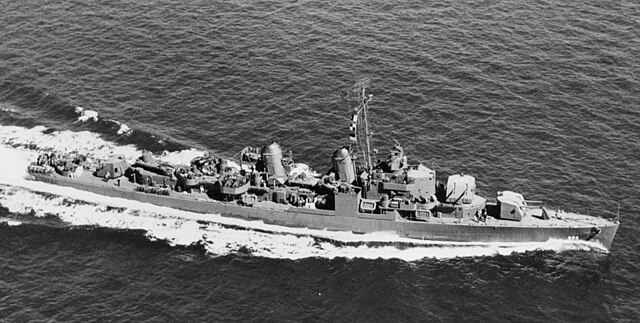
USS Moale was also from Federal Shipbuilding and Dry Dock Company in Kearny, New Jersey, she was launched on 16 January 1944, commissioned in the Brooklyn Navy Yard 28 February 1944, made a Bermuda shakedown, but stayed on the east coast for precommissioning new destroyer crews. On 21 August she met USS Missouri, USS Alaska, and joined DesDiv 120 en route for British West Indies, Panama Canal Zone, and via San Pedro, arrived at Pearl Harbor on 15 September for carrier screening and other specialized training until 23 October. She headed for the Western Carolines with DesRon 60, Ulithi 5 November, and the 3rd Fleet’s fast carriers (TF 38) for the Campaign of the Philippines, Leyte, Luzon and Mindoro. On the 27th she joined the 7th Fleet, TG 77.2 in San Pedro Bay and took part with USS Sumner in the Battle of Ormoc Bay (see above) on 2 December.
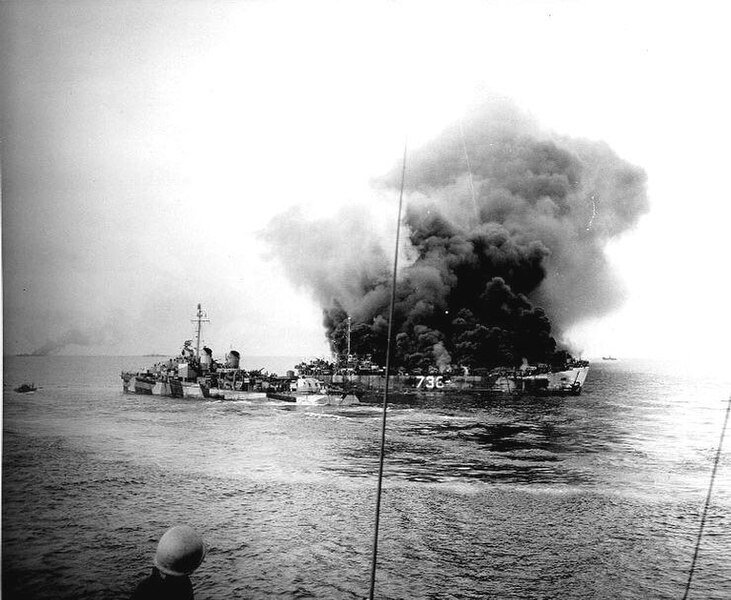
On 15 December, she covered troops and provided AA protection in Mangarin Bay, trying to repel ten kamikazes falling on LSTs, claiming at least one, others shared. Two ships were hit and she assisted the badly damaged LST-738, which later sunk. Herself had one KiA and 13 wounded but she picked up 88 survivors.
USS Moale then was ordered to Leyte Gulf on 17 December, completing a high speed cargo run to Ulithi and back. By 3 January 1945, she joined Vice Admiral Jesse Oldendorf’s TG 77.2 off Luzon and screened them on the 6th during the San Fernando, Lingayen Gulf bombardments. On the 9th she joined the gunfire, alternating with ASW/AA cover patrols until 22 January. Back to Leyte she joined the 5th Fleet (TF 58) again to Ulithi. On 10 February the sailed for strikes of the 16–17 February as preparations for Iwo Jima. In her unit, DesRon 60, USS Barton and Ingraham were damaged by collision on 16 February. They were escorted by USS Moale to Saipan and en route she assisted sinking a Japanese armed merchantman and coastal vessel. On 19 February she was back with TG 58.4 and to screening carriers on the 21th off Iwo Jima.
Caught by a typhoon and 40-foot (12 m) waves crashing on her, she had her deck damaged as well as her No. 1 mount so she left the Volcano Islands on the 25th for Pearl Harbor and back on 3 June at Ulithi, then Hagushi Anchorage in Okinawa on 7 June and CTG 31.5 for AA defence duties. On 27 June she took the dangerous radar picket station, but for one day. At Leyte she joined TG 32.12, 3th Fleet to Okinawa, covering minesweepers in Operation Juneau. She had reslenishment and rest in San Pedro Bay, when hearing of the surrender on 15 August. Five days later she joined TG 38.4 off Japan, patrolling, used as weather ship and air route radio beacon. On 27 September she left Japan via Guam to California, and her new peactime carrer. She would be decommissioned on 2 July 1973.
 USS Ingraham (DD 694)
USS Ingraham (DD 694)
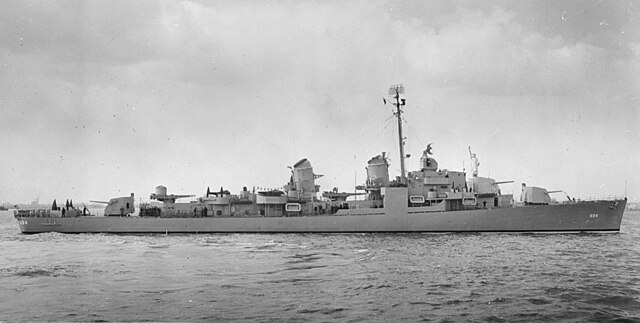
Also built at Keany, NJ, launched on 16 January 1944 and Commissioned on 10 March 1944, Ingraham after fitting out made her shakedown in Bermuda, with training off Norfolk and proceeded vya Panama to the Pacific, reporting at Pearl Harbour, training, then sent to Eniwetok on 31 October 1944 and later join TF 38 as a screen. By mid-November 1944, she took part in the strikes on Luzon, alternated between patrols, AA cover, ASW sweeps, until 12 December 1944. She took part in the landings on Mindoro. On 15 December with USS Barton, she sank a Japanese cargo ship southwest of Mindoro.
She left San Pedro Bay on 2 January 1945 for the Lingayen Gulf operations, on 6 January 1945, between AA cover and gunfire support. Later in January 1945, she screen the carriers of TF 58 raiding the Japanese homeland. After upkeep at Saipan on 20 February she took part in the invasion of Iwo Jima on the 23th, with USMC call fire. On 21 March she was in radar picket duty for the raid on Okinawa-Gunto. On 4 May 1945 during a massive air attack she claimed four, with a fifth crashing above the waterline on her port side, the bomb exploding in the generator room. She only had one gun left, 51 casualties including 15 dead so she retired to Hunter’s Point in California under escort to be repaired, when V-Day arrived. But she was just the start of a very long career: Decomm. on 15 June 1971 she was Sold to Greece as Miaoulis, and served until 2001 (sunk as target). She won 4 battle stars for WW2 and one for the Korean war.
 USS Cooper (DD 695)
USS Cooper (DD 695)
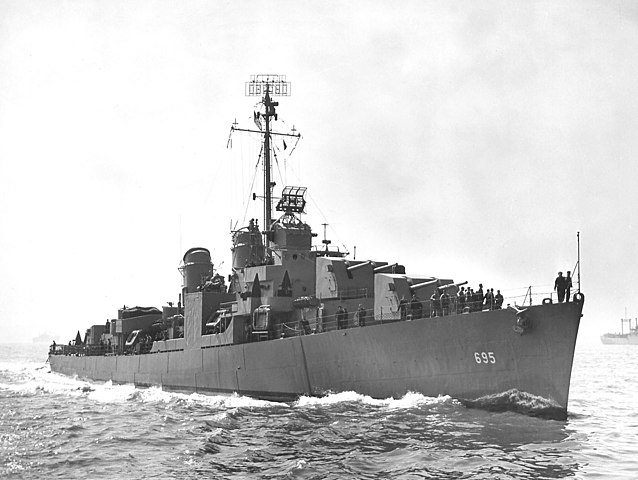
USS Cooper was launched on 9 February 1944 at Federal, Kearny, commissioned 27 March 1944, under command of J. W. Schmidt. After fitting out at Boston, short shakedown and training she left on 23 July 1944 for Panama, the west coast, Pearl Harbor (4 September) and after operational training, Ulithi on 5 November. Like her sister she became a screen for TF 38 raiding Luzon, Ormoc Bay, and Manila Bay until 19 November.
In San Pedro Bay (Philippines) by 29 November she joined the patrolling screen in Leyte Gulf until 2 December, and with USS Allen M. Sumner and Moale was detached to hunt down Japanese shipping in Ormoc Bay leading to a battle. At 00:13 on 3 December she received one Type 96 “Long Lance” torpedo from the Matsu-class IJN Take. It is reported the impact could have been survived, but it caused apparently an explosion on her starboard side suggesting it blasted on an ammunition store. The result was she broke in two and sank in just a minute. Survivors were left to fend for themselves as the other destroyers could not stop, being under intensive fshore fire, MTB and air attacks. Ar 14:00, “Black Cat” Catalinas were able to save 168 of her crew. She was awarded one battle star for her service.
 USS English (DD 696)
USS English (DD 696)
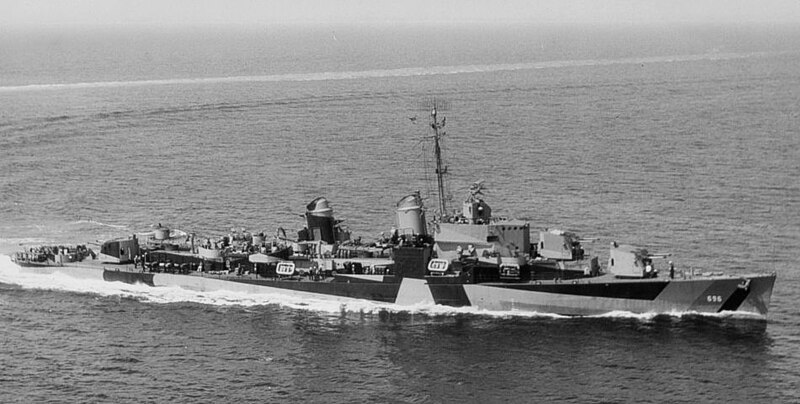
USS English was launched on 27 February 1944 at Federal, Kearny, commissioned on 4 May 1944 and had the same routine preparation as the others. Long story short she headed for Pearl Harbor by 3 September 1944, and in addition for her operation training, qualified aviators in carrier operations. On 17 December she sailed for Ulithi, and on the 28th, TF 38, for striked two days later on Formosa, Luzon, Okinawa, French Indochina in preparation for the invasion of Lingayen Gulf.
On 12 January 1945 she made a “blue on blue” attack on USS Rock (SS-274) in the South China Sea by gunfire at 9,200 yards (8,400 m) but she crash-dived to 300 feet (91 m) and survived. After rest and resplenishment at Ulithi until 8 February, she was ordered to Saipan to escort USS Indianapolis to join TF 58 for airstrikes around Iwo Jima, Tokyo area, and also for the upcoming Okinawa operation.
She took fuel and stores at Ulithi on 4-14 March and returned with TF 58 for strikes on Kyushu before taking part in the Okinawa operation. She also assisted the badly damaged USS Franklin on 19 March, screening her to safety and rejoined strikes on Okinawa and around before assault. On 1 April, she brought Naval gunfire support and returned to screening and patrols. She was detached to shell Minami Daito Shima on 10 May. On the 11th she assisted the badly damaged USS Bunker Hill and evacuated Vice Admiral Marc Mitscher and staff to another carrier.
She had a RAS at San Pedro Bay until 1 July and returned with TF 58 for final airstrikes on the homeland, Honshū on 18 July, hunting for enemy shipping in Sagami Wan and bombading Nojima Saki. She went on patrolling untl 15 August. She was in Tokyo Bay by 10-19 September and escorted occupation troopships from the Marianas, then left Sasebo for Boston via the Indian Ocean, Med, Atlantic, (26 April 1946). She earned 4 battle stars. She would also fight in Korea, took part in the Suez Crisis, Cuban Missile Crisis and was decommissioned in 1970, passed on to the ROCN until decom. in 1999.
 USS Charles S. Sperry (DD-697)
USS Charles S. Sperry (DD-697)
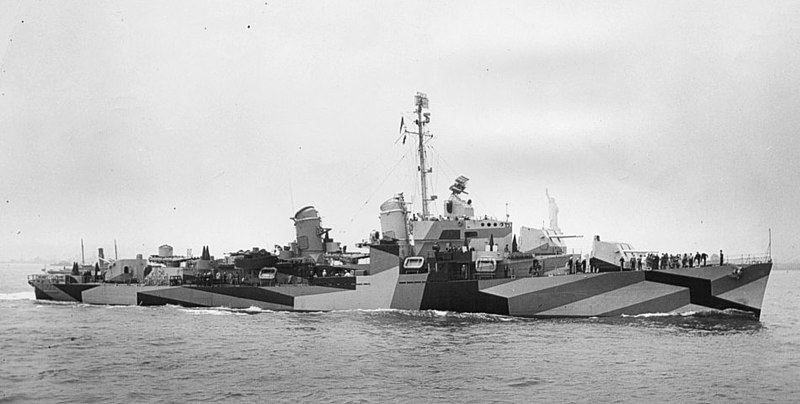
USS Charles S. Sperry (named after the commanding officer of Yorktown) was launched on 13 March 1944 at Federal, Kearny, commissioned 17 May 1944 and had the same routine start as her sisters, plus intensive advanced training in the Hawaiian Islands, before reaching Ulithi on 28 December 1944, joining TF 38 and screening them from 30 December, in their airstrikes on Formosa, Luzon (assault on Lingayen Gulf) then Indochina, Okinawa. She was back in Ulithi on 26 January 1945. She sailed with TF 58 on 10 February for the invasion of Iwo Jima. She escorted them for the raid on Tokyo. On 16-17 February she provided AA cover during fierce counterattacks. She provided gunfire on demand to the Marines at Iwo Jima later and repelled air attacks on 19 February and 20–21 February. Combinging skilled manoeuvers and protective smoke screen plus firce and accurate fire she prevented damage. After another raid she was back at Ulithi on 5 March.
Now again under TF 38, she left on 14 March for Okinawa until 1 June. She covered an air strike against Kyushu and repelled attacks on 19- 20 March, covering the damaged USS Franklin and was back for strikes on Okinawa.

USS Charles S. Perry assisting USS Bunker Hill on 11 May 1945
She was called for gunfire on an airstrip on Minami Daito Shima on 27 March. She provided plane guard duties on 1 April 1945, and on 7 April, heard abot the sinking of Yamato and escort. She claimed several kamikaze during attacked on 11, 14, 16, 29 April, 11 May and assisted the damaged USS Hancock and Bunker Hill.
She was in San Pedro Bay for RAS 1 June-1 July and met TF 38 for the final strikes on the home islands, and after 15 August, covered occupation landings, POWs evacuations and by 31 August went in Tokyo Bay to assist in the surrender ceremonies in Tokyo Bay on 2 September. She won four battle stars for WW2, four for the Korean War. She also cruised in the Mediterranean with the 6th Fleet until converted to FRAM in 1958-59, and by 8 January 1974, was transferred to Chile as Ministro Zenteno (D-16), scrapped in 1990.
 USS Ault (DD 698)
USS Ault (DD 698)
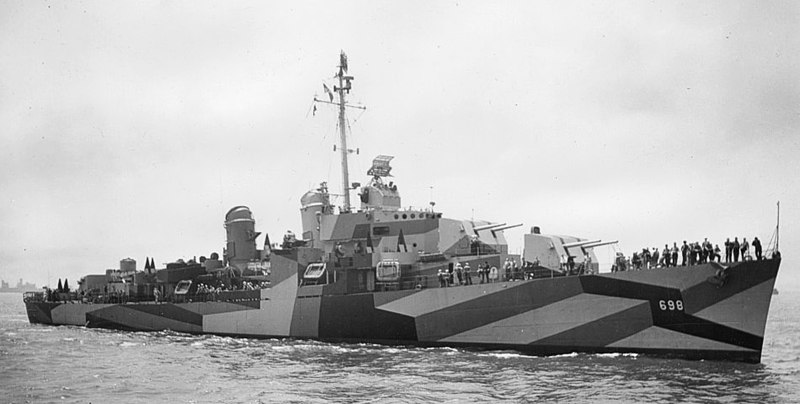
Built by Federal, Kearny, USS Ault was commissioned 31 May 1944 (Capt. Joseph C. Wylie in command) and departed New York on 10 July 1944 for shakedown and back for post-shakedown availability. On her way to the Pacific she escorted USS Wilkes-Barre, to Trinidad, transited via the Panama Canal to San Diego, Pearl Harbor on 29 September and after three months of training sailed to Ulithi on 18 December. She joined VADM John S. McCain’s Fast Carrier Task Force after a stop at Eniwetok. She was assigned to DesRon 62, and RADM Gerald F. Bogan’s TG 38.2.
Her part of the Philippines campaign included strikes on Luzon and Formosa which which took part in January 1945. She then sailed to the Bashi channel with USS Waldron, Charles S. Sperry, and John W. Weeks screening TF 38 into the South China Sea, but marred by heavy weather. She covered strikes on Cam Ranh Bay area, Hong Kong, Hainan, Swatow, and the Formosa Strait and Okinawa from 20 January, then back to Ulithi on the 25th.
With the renamed TG 58.3 she covered new strikes on the Japanese mainland (16-17) and operations against Iwo Jima on 19 February, the raid on Tokyo (25)d Okinawa (1 March).
After another RAS at Ulithi she was back on 14 March to secure the surrounding for the Okinawa campaign. On 20 March she shot down two planes. On the 27th she covered DesRon 62 and four cruisers sheling Minami Daito Shima. On 6, 7, 11 April she tried to repel Kamikaze attacks with one missing Essex to near-crash on USS Ault. She also bombarded Minami Daito Shima on 10 May. She screened USS Bunker Hill on 11 May, shooting down one kamikaze and later rescued 29 men. She fended off more attacked on the 13-14 splashing three more. On 1 June she had a RAS in San Pedro Bay, and later screen TF 58 raiding the Japanese home islands. On 18-19 July she screened CruDiv18 in Sagami Wan and Nojima Saki. She covered the carriers until 15 August.
She entered Tokyo Bay on 2 September, anchored near USS Missouri. After Sasebo, she departed Japan for home on new year’s day, San Francisco on 20 January 1946, then Boston and early east coast service, the overhaul in Boston on 26 April 1946. Her cold war career included the Korean war, Mediterranean, and Vietnam, and was decommissioned on 16 July 1973 after 29 years service, earning 5 ww2 battle stars, 2 more for Vietnam.
 USS Waldron (DD 699)
USS Waldron (DD 699)
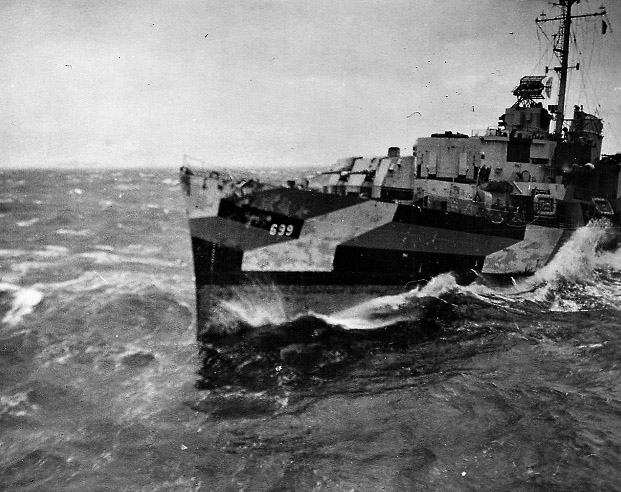
USS Waldron was commissioned at the New York Navy Yard on 7 June 1944 and after shakedown off Bermuda in the early summer of 1944, post-shakedown availability at New York, she returned to Bermuda area for more training, then New York again by mid-September and on the 26th she went for the Panama Canal on 1 October, Balboa on 4 October, San Pedro, and Pearl Harbor, on 20 October for furthrt training until 17 December, and Ulithi lagoon on 28 December reporting to TF-38.
She departed on 30 December for first striked on 3-4 and 6–7 January on Luzon. She took part in the Lingayen Gulf campaign before a raid on Formosa, South China Sea, Cam Ranh Bay until 12 January. The refuelled to a carrier the following day and screened attacks on Hainan Island, Hong Kong, Formosa again. They were back at Ulithi on the 26th after a final raid on Okinawa.
This time with TF 58, she took part in the operation on Iwo Jima and strikes on Japan proper, Tokyo area, Honshū. On the night of 17-18 February, Waldron encountered several small Japanese patrol craft and after spotting one, charged and rammed her at 0509 on 18 February. She moved to Saipan for bow repairs on 20 February and was back on the 25th off Iwo Jima, reporting to TF 51, as transport screen and providing gunfire support then two days later, TG 58.3 for an air strike on Okinawa and back to Ulithi on 4 March.
Ten days later she was in Japanese home waters for strikes on Kyushu airfields, repelling kamikazes and covering the damaged Franklin. On the 20-21 March night she picked by radar a Yokosuka D4Y “Judy” and shoot it down. On 22 March she resumed cover for Okinawa and Kyushu raids as for the next three months, detached for two shore bombardments on Minami Daito Shima. On 14 May she claimed four sure assists. On 1 June she was San Pedro Bay for RAS, until 1 July and back to TF 38 until 15 August. She took part in the occupation of Japan until 10 September, entered Tokyo Bay and later went back home.
After Mediterranean, Korea and Vietnam wars, she was decommissioned on 30 October 1973 in Mayport, sold to the Colombian Navy as ARC Santander, scrapped in 1986. She earned four battle stars during World War II, one for Vietnam.
 USS Haynsworth (DD 700)
USS Haynsworth (DD 700)
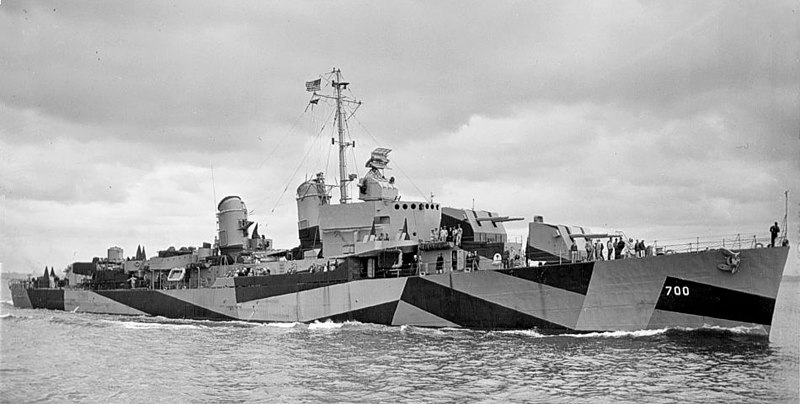
USS Haynsworth was commissioned on 22 June 1944. and after shakedown in the Caribbean, departed New York on 20 September escorting SS Queen Mary with PM Winston Churchill on board and back from Britain to New York then sailed on 26 September via Panama, San Pedro, to Pearl Harbor on 20 October for more training, and 16 December for Ulithi and the Fast Carrier TF 38, screening them for three months, which included raids in the final phase of the Philippines, south China sea, Formosa, Luzon, Indochina and then back on Okinawa, wit RAS at Ulithi on 26 January. Then with TF 58 for strikes in the Tokyo area.
On 16 February while close to Tokyo Bay in heavy weather and low ceiling, three Japanese picket boats were spotted by Haynsworth and sunk, taking 12 prisoners. After another RAS at Ulithi she followed the fleet for more strikes against Japan, Kyushu, the Inland Sea (18-19 March) shelling Minami Daito Shima and the campaign of Okinawa; providing shore gunfore cover support, while repelling Kamikaze attacks notably on 6 April whe she was badly hit. She was obliged to retire to Mare Island after Ulithi for full repairs. Next she became a training ship at Treasure Island, California from 17 July to 5 September.
She returned to Pearl Harbor but was back to the east coast on 14 January 1946, Boston (26 April), deactivated, mothballed in the Reserve Fleet, then reactivated by March 1947, and sent to Algiers, Louisiana, for reserve training cruises in the Gulf and Caribbean until the summer of 1949. For WW2 service she won the Asiatic–Pacific Campaign Medal with three battle stars. Her postwar service saw her in Korea, Mediterranean, but she was decommissioned and stricken on 30 January 1970, sold to the Republic of China, served as ROCS Yue Yang (DD-5). untile sunk as artificial reef on 2001.
….
(More to come)
….
 USS Mannert L. Abele (DD 733)
USS Mannert L. Abele (DD 733)
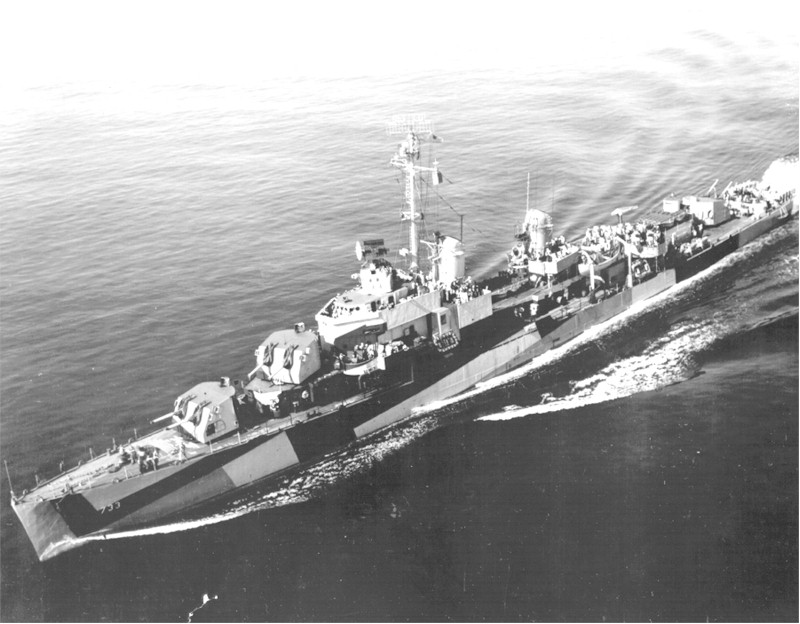
USS Mannert L. Abele built at Bath Iron Works in Maine, 9 December 1943, commissioned at Boston for fitting out by 4 July 1944. After shakedown off Bermuda she trained destroyer crews in Chesapeake Bay, sailed to Norfolk on 16 October, crossed Panama to San Diego, and Pearl Harbor on 17 November followed by two weeks of hard training. She escorted a convoy on 3 December and was back to Pearl to be converted on orders to a fighter director ship. She had a special radio and radar for enhancing her role as radar picket and trained until departing on 27 January 1945 for the invasion of Iwo Jima.
Sge was assigned to the transport screen of VADM Richmond K. Turner’s TF 51 via Eniwetok and Saipan to the landing area on 19 February. The 20th she was par tof the fire support group for 28 hours with night illumination for the 5th Marine Division and returned to radar picket duty on 21 February. On 3–4 March, 8–10 March, she returned to fire support and sailed out for a RAS on 10 March at Ulithi, then out of 20 March as radar picket off Ulithi. Next she joined TF 54 (RADM Morton Deyo) for the invasion of Okinawa. From the Ryukyus on 24 March, she sailed to Kerama Retto and Ie Shima and supported UDT operations (commando divers) to the beaches. On 1st april she provided close fire support and back to radar picket patrols northeast of the island. On 3 April, she spotted and tried to repel three Japanese planes, downed two, damaged the third. On 5 April she patroled off the beaches, answered support calls. On 6 April she co-claimed a twin‑engined bomber.
Sge returned to TF 54, protecting transports off Okinawa from Surface Special Attack Force (Suicide Shin’yō Boats) and heard about the sortie of the battleship Yamato and its battle group beig hammered and sunk. Back to radar picket duty on 8 April she patrolled 70 nmi northwest of Okinawa with LSM(R)-189 and LSM(R)-190. On 12 April she spotted kamikaze and was soon targeted by three Aichi D3A “Vals” at 13:45, drove two back, downed a thord aiming at LSM(R)-189. At 14:00 15-25 arrived from the North and started to attack from all sides. One light bomber was hit and repelled but stayed around for one hour and a half;
14:40, saw three A6M Zero loaded with bombs. She drove off one, shot down another and nearly destroyed a third, which still managed to crash into the starboard side. The bomb penetrated the engine room before exploding. LSM(R)-189’s captain would later report it was difficult to evaluate what hit her exactly.
But USS Mannert L. Abele had her keel broke midships close to No. 2 funnel, lost control and power. At 14:46 she took a direct bomb hit from a Yokosuka MXY-7 Ohka on her starboard waterline close to the forward fireroom. Its 2,600 lb (1,200 kg) warhead achieve the work, she broke in two, bow and stern sections sinking rapidly. Fortunately survivors could be rescued by nearby LSM(R)-189 and LSM(R)-190 which shot down two remaining attackers and managed to repell further attacks. In all, Abele sunk with 84. She became the first of three radar pickets hit by Ohka “human missiles” and osole sunk that way at Okinawa. Her wreck was located in 2022, 75 miles (121 km) off the northern coast.
 USS Drexler (DD 741)
USS Drexler (DD 741)
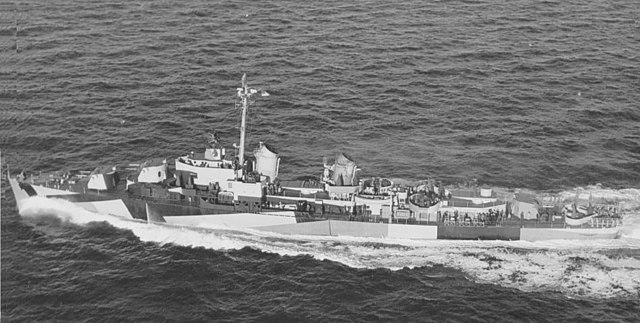
USS Drexler was bult at Bath in Maine, commissioned on 14 November 1944. After trials and Bermuda quick shakedown, she sailed from Norfolk on 23 January 1945 to escort USS Bon Homme Richard to Trinidad and proceeded to San Diego on 10 February, then Pearl Harbor for exercises over two weeks, the escorted ships to Guadalcanal and Ulithi and was prepared for the Okinawa invasion.
Departing Ulithi on 27 March 1945 for Okinawa she was assigned as radar picket station. On 28 May, 07:00, she was targeted by two kamikazes as USS Lowry. The first was downed and the narrowly missed Lowry but hit Drexler. She lost all power, had a gasoline fire but kept firing and shot down two more attacking after the crash. At 07:03 she was hit again by a heavier Yokosuka P1Y1 Ginga “Frances”. The impact was such she rolled all over her beam ends, and rapidly sank (witnesses said around 50 seconds) taking with her 168 men, with 52 wounded included the captain.
 USS Meredith (DD-726)
USS Meredith (DD-726)
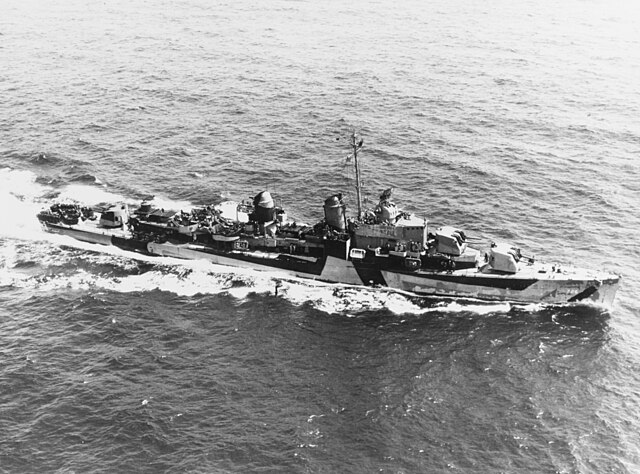
Meredith was built at Bath Iron Works Corporation, Bath, Maine, commissioned on 14 March 1944. After trials, initial trials and shakedown off Bermuda, she departed Boston on 8 May 1944 as an convoy escort to Plymouth, England, 27 March. She was of the reare destroyers actually fightinh in the Atlantic. On 5-6 June, escorted transports for the Normandy invasion. On D-Day, she was detached for gunfire support on Utah Beach. When done, she left to patrol offshore waters when stricking a mine. She survived the blast though severely damage, having 7 killed and 50+ wounded or missing, all power went down so she had to be towed to an anchorage in the Baie de Seine, however on 9 June, in one of the rare Luftwaffe attacks she had near-misses which further aggravated flooding and weakened her hull so much she eventually broke in two suddenly, and sunk with only 163 rescued by USS Bates. The hull was retrieved in early 1960 hulk, raised and scrapped in September.
….
(More to come)
….
 USS Douglas H. Fox (DD 779)
USS Douglas H. Fox (DD 779)
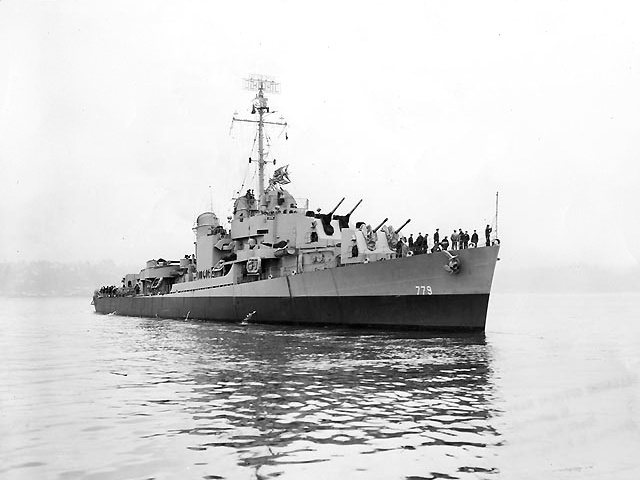
Douglas H. Fox was built at Todd-Pacific Shipyards, in Seattle, commissioned 26 December 1944. After shakedown, she sailed to the Hawaiian Islands and trained there from 31 March 1945 to 21 April 1945 and was given the dangerous task of radar picket line at Okinawa, from 5 May 1945.
She was attacked and downed 7 planes out of 11 enemy planes, including 5 alone when one kamikaze with bomb hit, and she was sprayed with gasoline. She had 7 killed, 35 wounded, but fires were mastered, damage control was efficient so she could evacuate to Kerama Retto for temporary repairs and then San Francisco for permanent repairs on 23 June. She was still there on 15 August at V-Day.
So postwar she was assigned to the east coast from 30 September 1945, New York City in October for Navy Day celebrations, then HP Norfolk on 2 November 1945, plane guard duty in the Caribbean and escorted the brand new USS Franklin D. Roosevelt for her shakedown from 14 January 1945 and visited Rio de Janeiro in February 1946. After remaining in the Carribean until 14 December 1946 she sailed for New London. For her WW2 service she won one battle star, and another for her Korean service. She served in the Atlantic-Mediterranean, was converted FRAM II, and was eventually decom. and sold to Chile on 15 December 1973.
 USS Stormes (DD 780)
USS Stormes (DD 780)
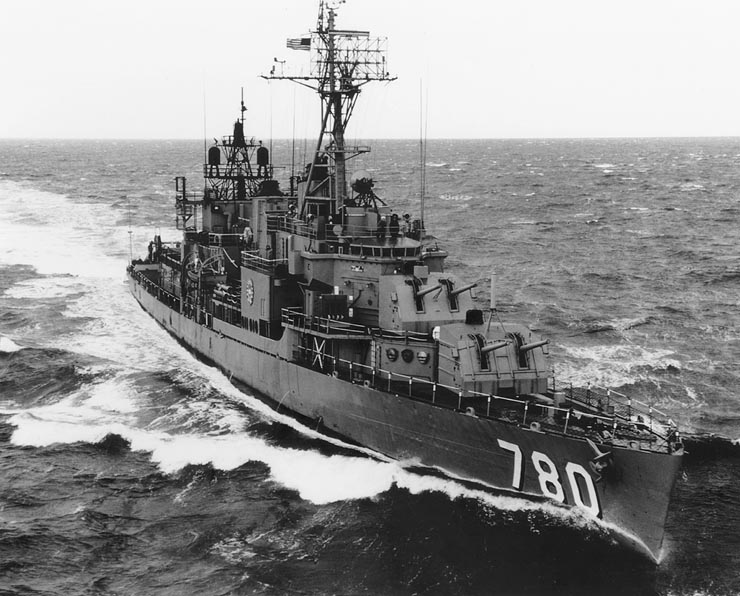
USS Stormes was built at Todd-Pacific, she was commissioned on 27 January 1945. After trials and shakedown from San Diego Bay she sailed on 1 April for Bremerton for post-shakedown overhau until 22 April then sailed to Hawaii. She trained from 30 April, escorted USS Louisville to Okinawa via Guam, arriving on Hagushi anchorage (Southwestern Okinawa) on 23 May, 5th Fleet.
As part of the AA screen she left the anchorage and had to repel a first air raid the following evening in bad weather. This 25 May their radars picked up between rain squalls at 0905, several bogays. Planes went between two US Navy planes and targeted USS Ammen, ahead of Stormes. Shot down, it turned and crashed into Stormes’s aft torpedo mount and its bomb exploded in the magazine under N°5-in mount. The damage was immense. By noon fires had been extinguished, holes were plugges but this incident left her with 22 kills, 15 injured. She crawled back to Kerama Retto and stayed there until 5 July, then went to Buckner Bay’s floating drydock, repaired until 13 August then she sailed back home, on only her port shaft. She made the trip via Saipan, Eniwetok, and Pearl Harbor and to San Francisco’s Hunters Point, on 17 September. The war was over. For her short service she earned only one battle star for World War II, but will earn three in Korea, one in Vietnam. Ultimately she was transferred to Iran as Palang in 1972, and is decommissioned since 1994 (not BU yet).
 USS Robert K. Huntington (DD 781)
USS Robert K. Huntington (DD 781)
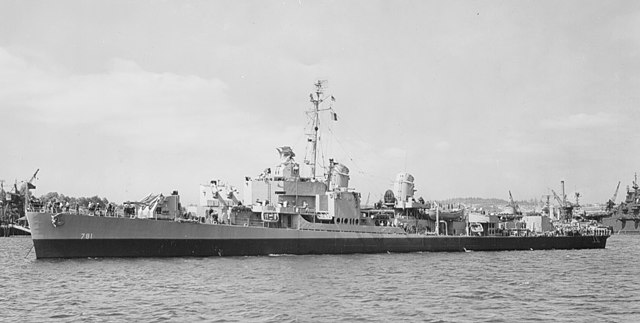
USS Robert K. Huntington (DD-781) was laid down on 29 February 1944 at Todd Pacific, she was launched on 5 December 1944, commissioned on 3 March 1945. After trials, shakedown and quick training she joined the Pacific Fleet on 31 May 1945 Via Pearl Habrour. From 27 June to 16 August 1945, she escorted ships between Eniwetok and Ulithi, not being part in great operations. On 28 August, she joined at last TF 58 off the Japanese coast, as an escort of USS Missouri, escorting her into Tokyo Bay for the surrender ceremonies. Once done, she returned to San Diego with 100 Marines aboard, and the war was over for her. Her career will include Korea, the Atlantic fleet and Vietnam (2 battle stars). She was eventually decommissioned on 31 October 1973, transferred to Columbia as Falcon, stricken in 1981.
 USS Bristol (DD 857)
USS Bristol (DD 857)
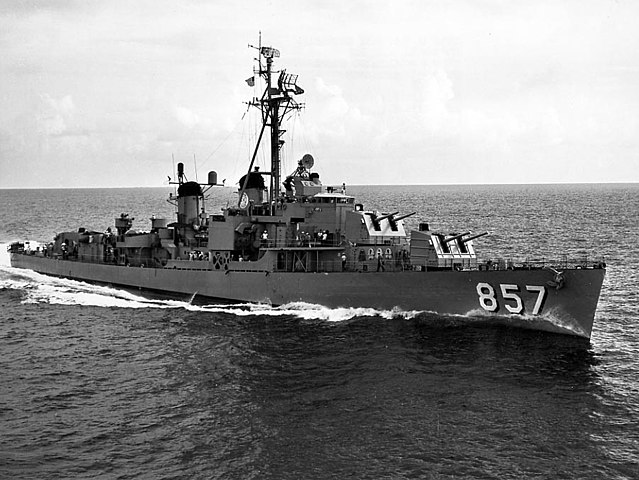
USS Bristol, 2nd after the one sunk in WW2 of the Gleaves class, was launched on 29 October 1944 at Bethlehem Shipbuilding in San Pedro (California), commissioned on 17 March 1945. She departed San Diego on 13 June 1945 for Pearl Harbor after a shakedown training, restricted availability, arriving on 19 June 1945, then she proceeded to Guam on 29 July and TG 30.8, the logistic support group attached to TF 38. On 5 August 1945 she collided with the transport Ashtabula and her bow was damaged to the point of returning to Guam for repairs, completed on 1 September. So she never really saw combat. Shee departed for Japan occupation duty until 21 February 1946, after which she headed back to San Pedro on 15 March.
USS Bristol received one battle star for WW2, two for Korea. In 1969 she was decommissioned and transferred to the Republic of China Navy as ROCS Hua Yang (DD-3), until 1993.

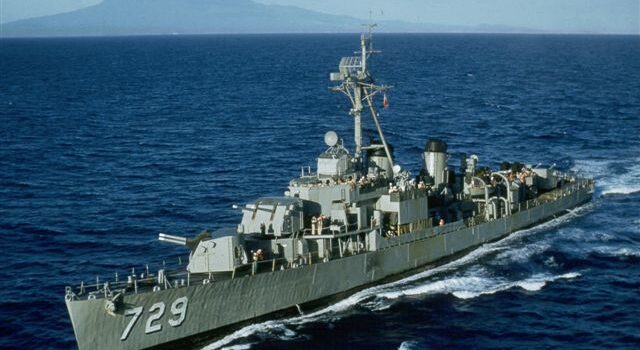
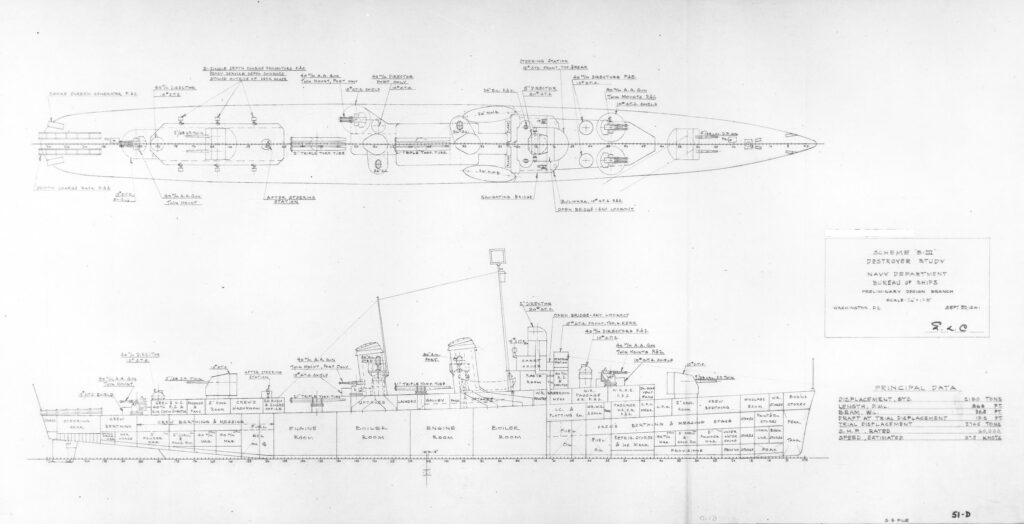

 Latest Facebook Entry -
Latest Facebook Entry -  X(Tweeter) Naval Encyclopedia's deck archive
X(Tweeter) Naval Encyclopedia's deck archive Instagram (@navalencyc)
Instagram (@navalencyc)





 French Navy
French Navy Royal Navy
Royal Navy Russian Navy
Russian Navy Armada Espanola
Armada Espanola Austrian Navy
Austrian Navy K.u.K. Kriegsmarine
K.u.K. Kriegsmarine Dansk Marine
Dansk Marine Nautiko Hellenon
Nautiko Hellenon Koninklije Marine 1870
Koninklije Marine 1870 Marinha do Brasil
Marinha do Brasil Osmanlı Donanması
Osmanlı Donanması Marina Do Peru
Marina Do Peru Marinha do Portugal
Marinha do Portugal Regia Marina 1870
Regia Marina 1870 Nihhon Kaigun 1870
Nihhon Kaigun 1870 Preußische Marine 1870
Preußische Marine 1870 Russkiy Flot 1870
Russkiy Flot 1870 Svenska marinen
Svenska marinen Søværnet
Søværnet Union Navy
Union Navy Confederate Navy
Confederate Navy Armada de Argentina
Armada de Argentina Imperial Chinese Navy
Imperial Chinese Navy Marinha do Portugal
Marinha do Portugal Mexico
Mexico Kaiserliche Marine
Kaiserliche Marine 1898 US Navy
1898 US Navy Sovietskiy Flot
Sovietskiy Flot Royal Canadian Navy
Royal Canadian Navy Royal Australian Navy
Royal Australian Navy RNZN Fleet
RNZN Fleet Chinese Navy 1937
Chinese Navy 1937 Kriegsmarine
Kriegsmarine Chilean Navy
Chilean Navy Danish Navy
Danish Navy Finnish Navy
Finnish Navy Hellenic Navy
Hellenic Navy Polish Navy
Polish Navy Romanian Navy
Romanian Navy Turkish Navy
Turkish Navy Royal Yugoslav Navy
Royal Yugoslav Navy Royal Thai Navy
Royal Thai Navy Minor Navies
Minor Navies Albania
Albania Austria
Austria Belgium
Belgium Columbia
Columbia Costa Rica
Costa Rica Cuba
Cuba Czechoslovakia
Czechoslovakia Dominican Republic
Dominican Republic Haiti
Haiti Hungary
Hungary Honduras
Honduras Estonia
Estonia Iceland
Iceland Eire
Eire Equador
Equador Iran
Iran Iraq
Iraq Latvia
Latvia Liberia
Liberia Lithuania
Lithuania Mandchukuo
Mandchukuo Morocco
Morocco Nicaragua
Nicaragua Persia
Persia San Salvador
San Salvador Sarawak
Sarawak Uruguay
Uruguay Venezuela
Venezuela Zanzibar
Zanzibar Warsaw Pact Navies
Warsaw Pact Navies Bulgaria
Bulgaria Hungary
Hungary

 Bundesmarine
Bundesmarine Dutch Navy
Dutch Navy Hellenic Navy
Hellenic Navy Marina Militare
Marina Militare Yugoslav Navy
Yugoslav Navy Chinese Navy
Chinese Navy Indian Navy
Indian Navy Indonesian Navy
Indonesian Navy JMSDF
JMSDF North Korean Navy
North Korean Navy Pakistani Navy
Pakistani Navy Philippines Navy
Philippines Navy ROKN
ROKN Rep. of Singapore Navy
Rep. of Singapore Navy Taiwanese Navy
Taiwanese Navy IDF Navy
IDF Navy Saudi Navy
Saudi Navy Royal New Zealand Navy
Royal New Zealand Navy Egyptian Navy
Egyptian Navy South African Navy
South African Navy






























 Ukrainian Navy
Ukrainian Navy dbodesign
dbodesign